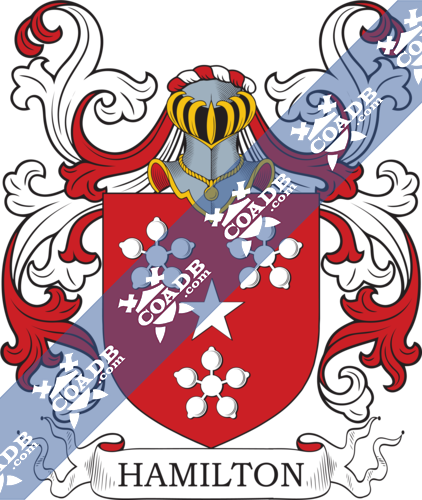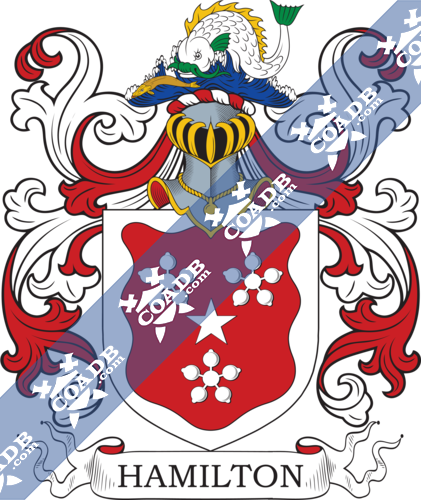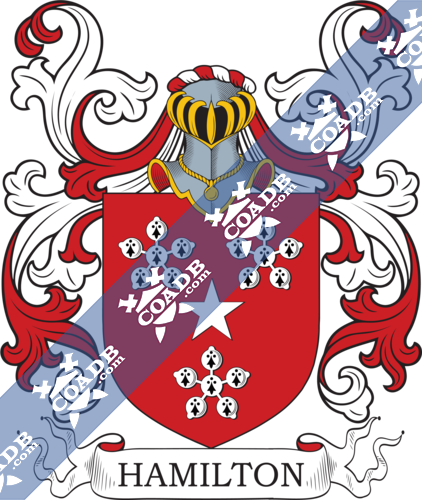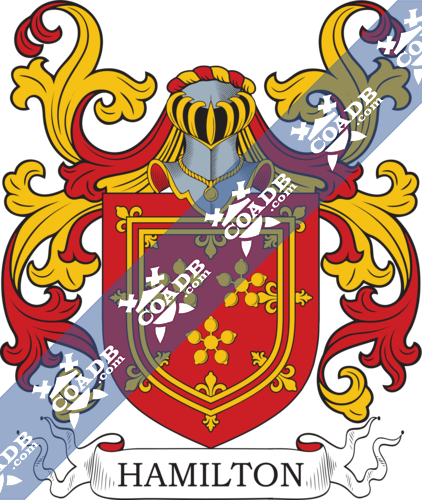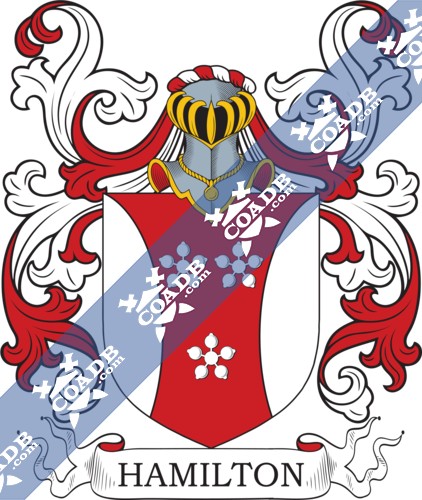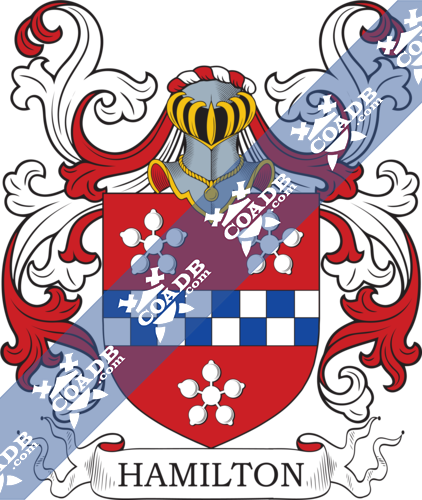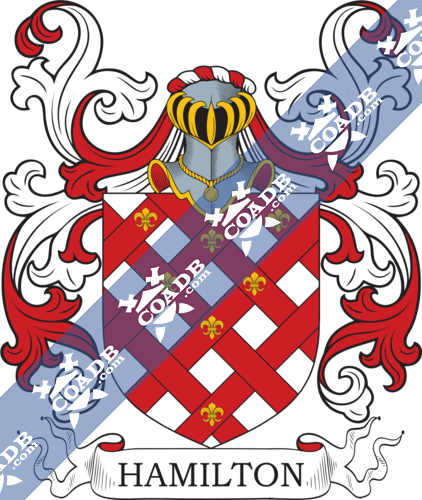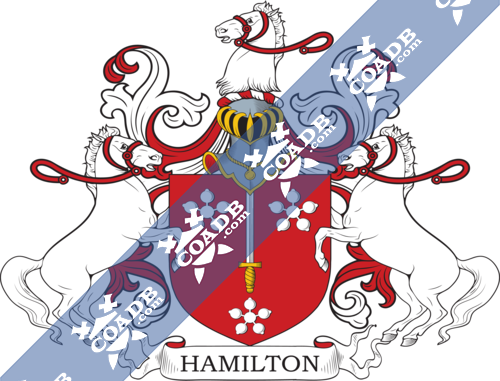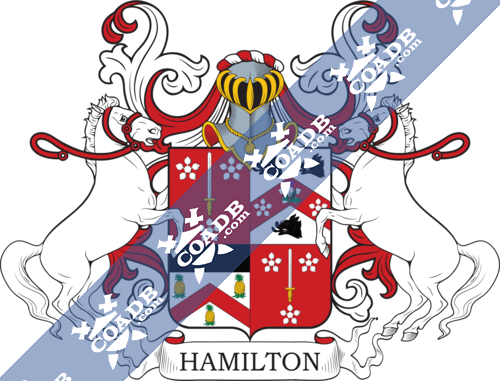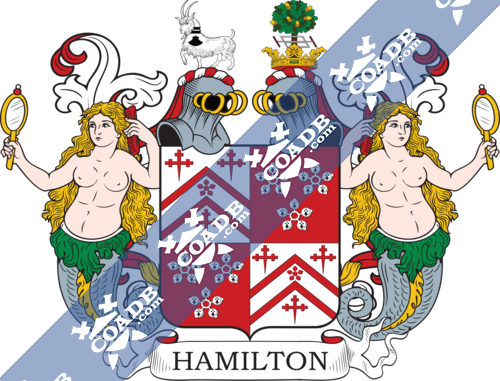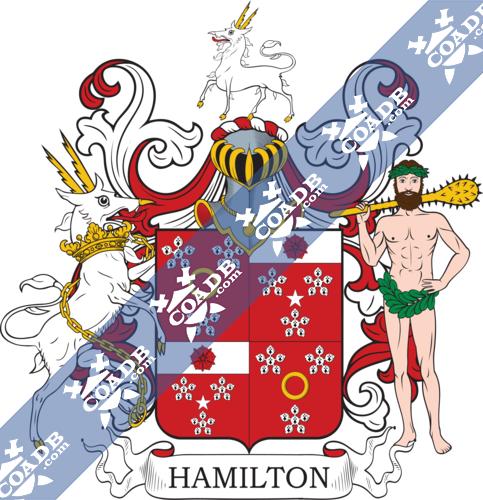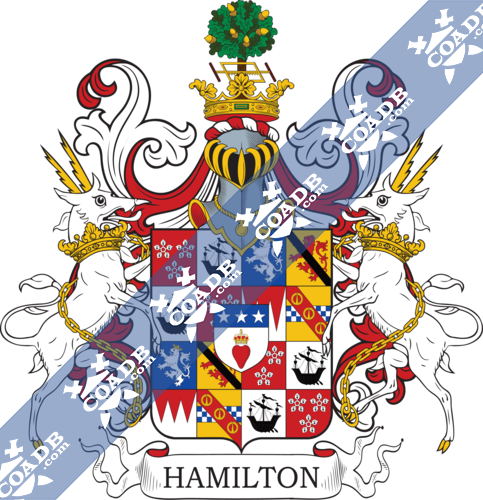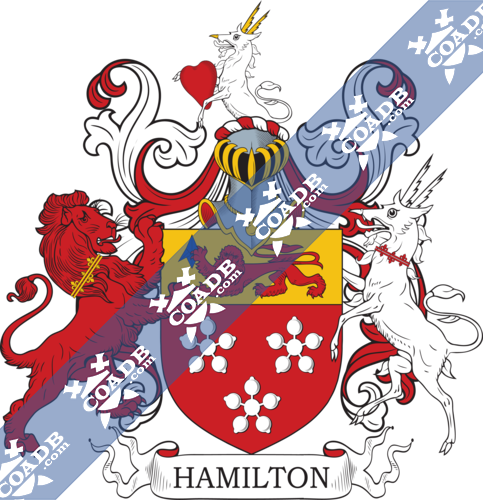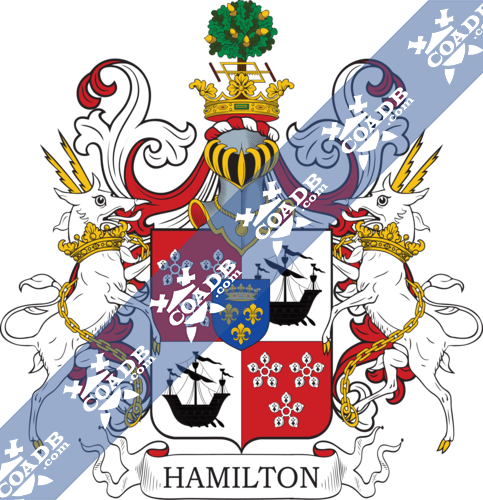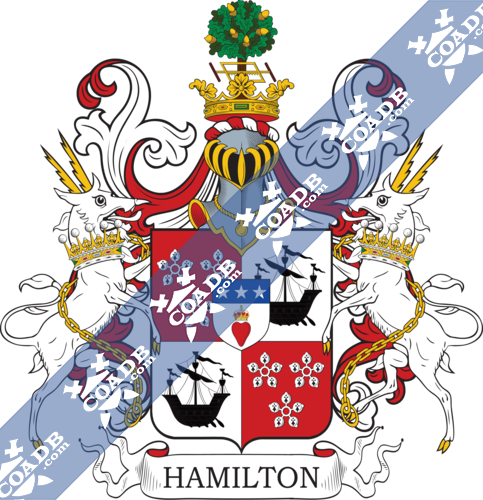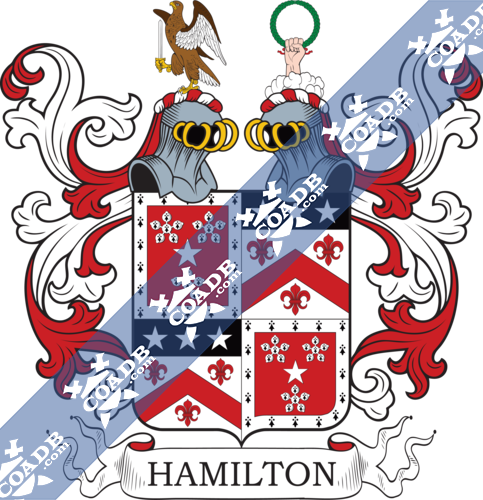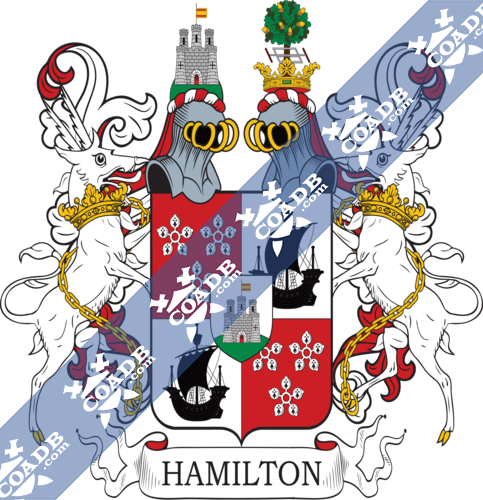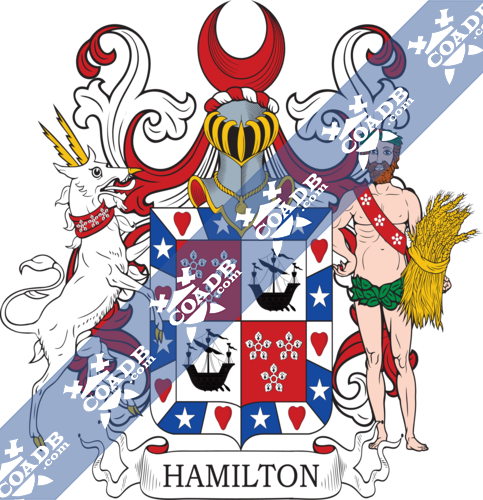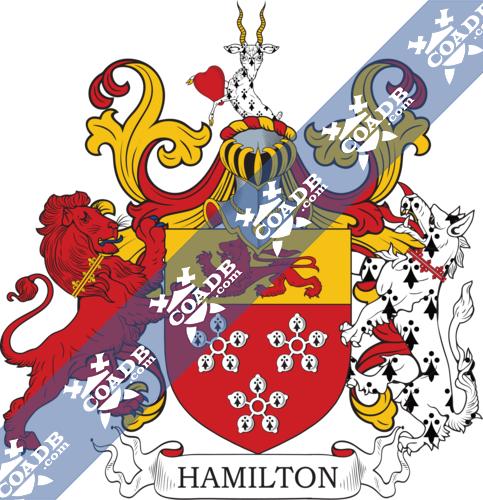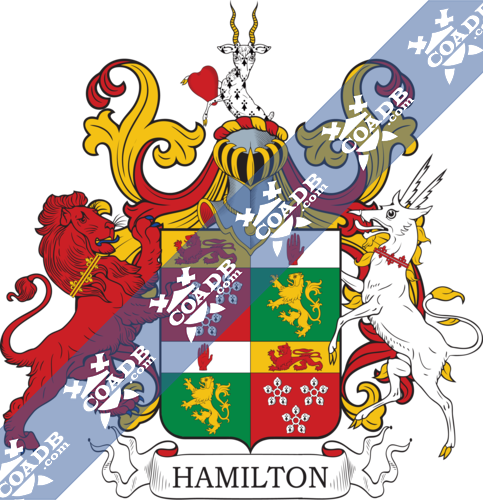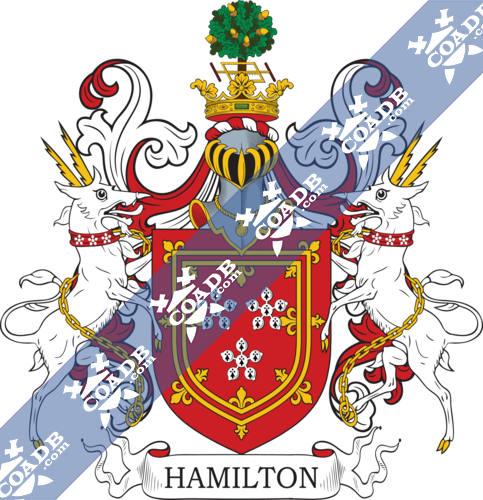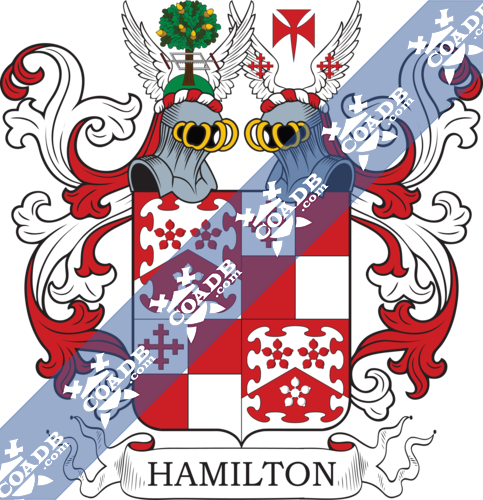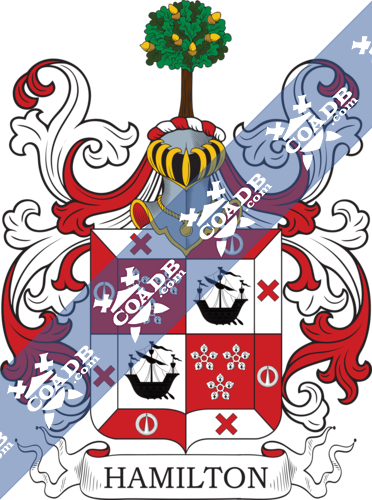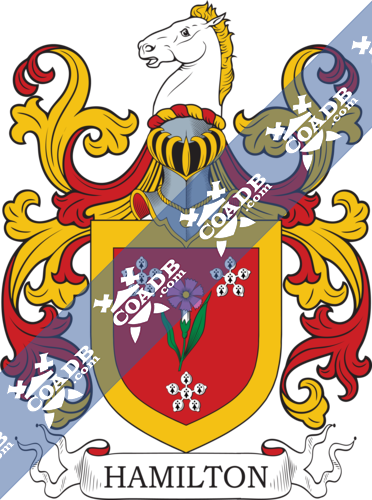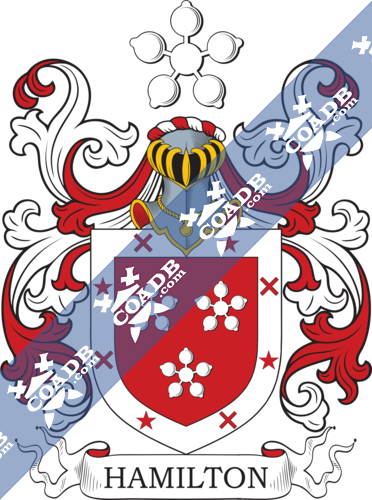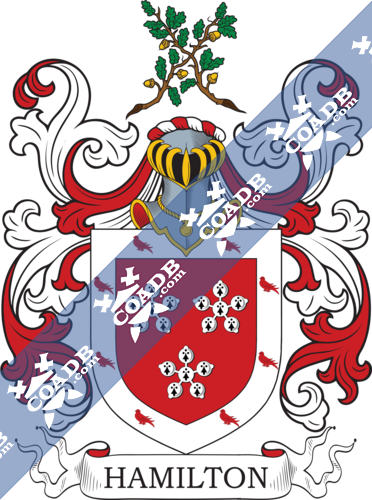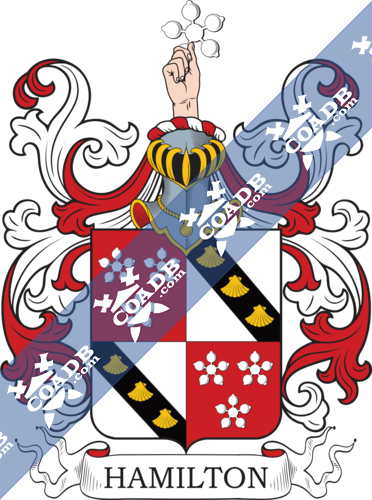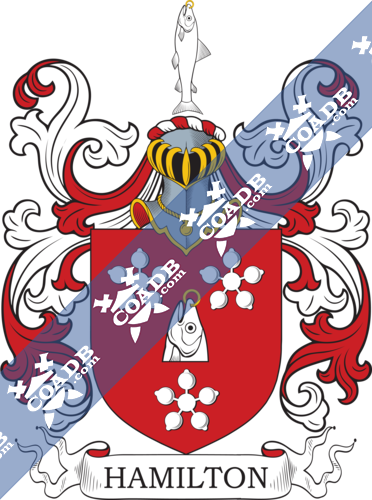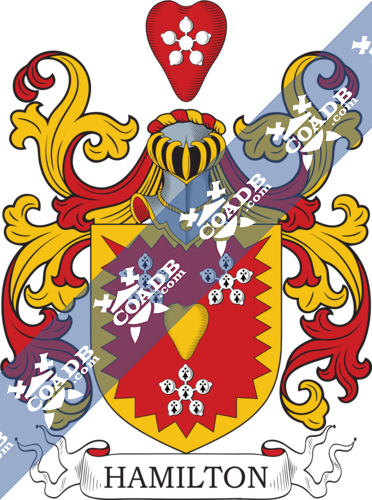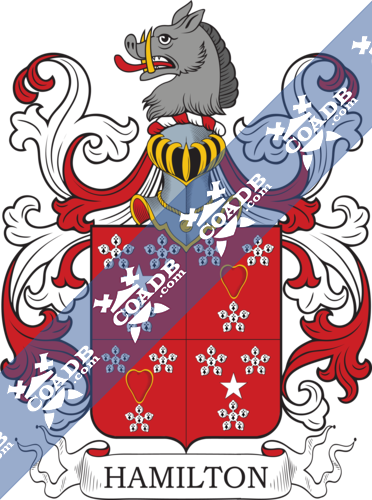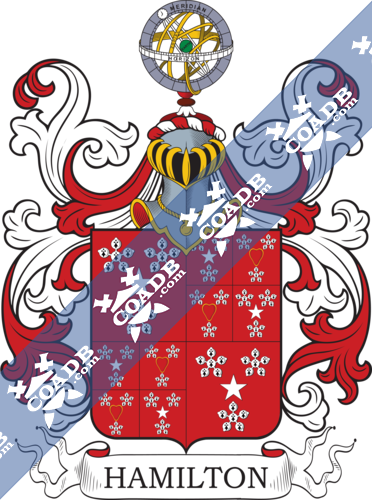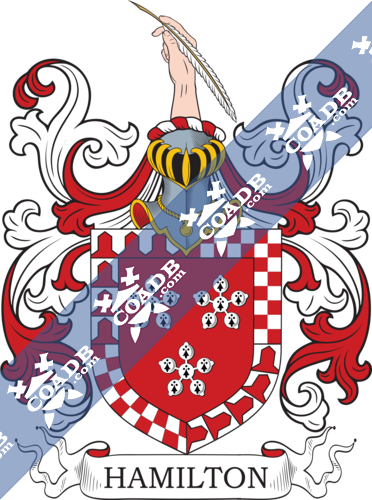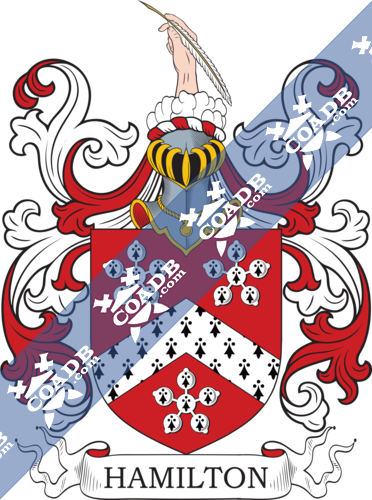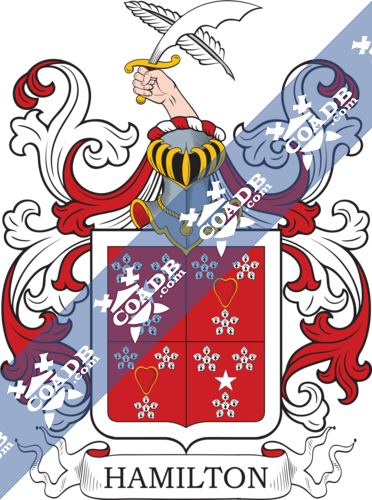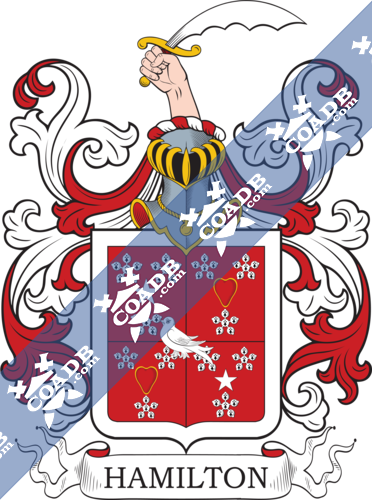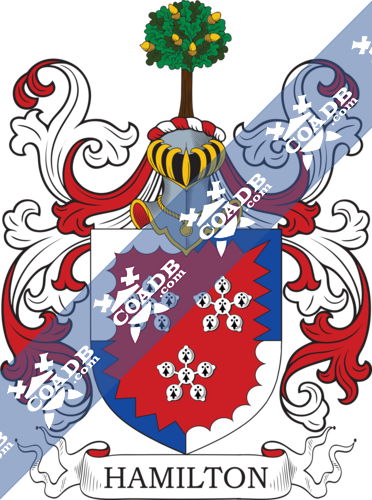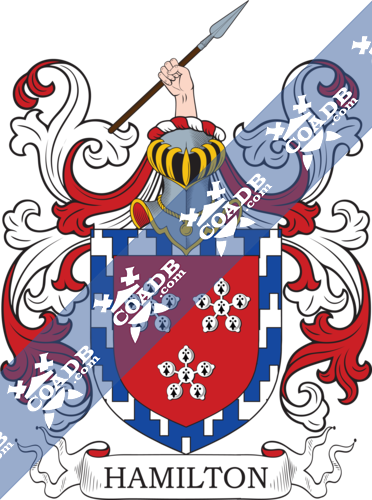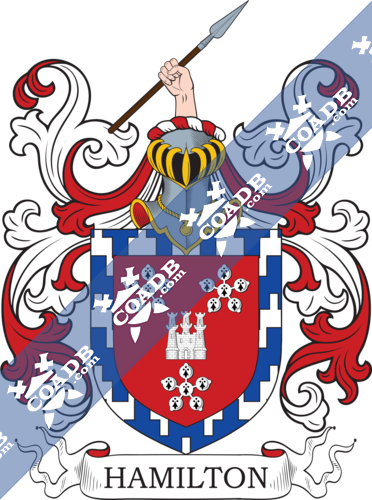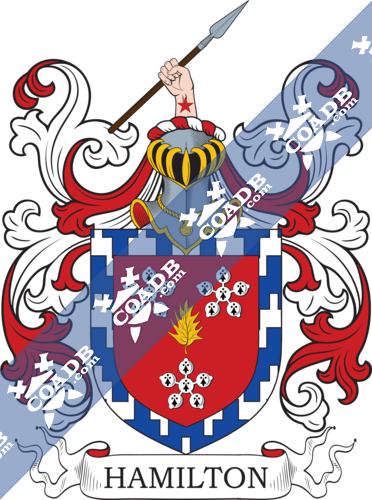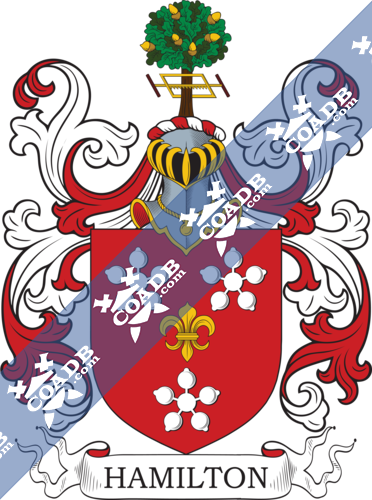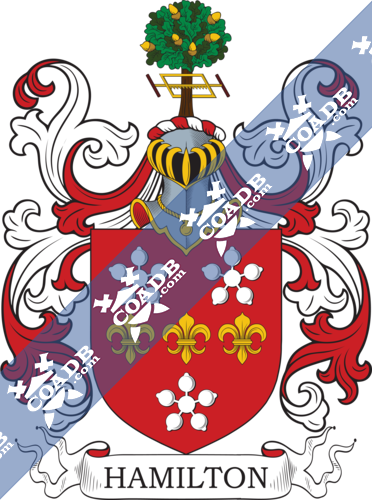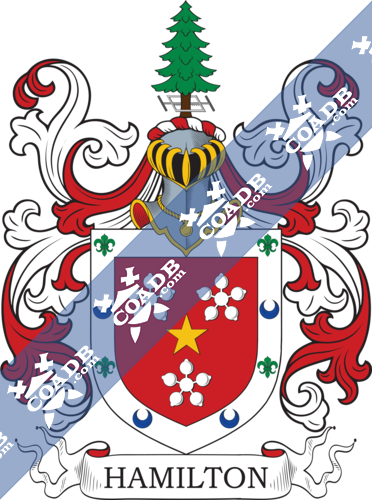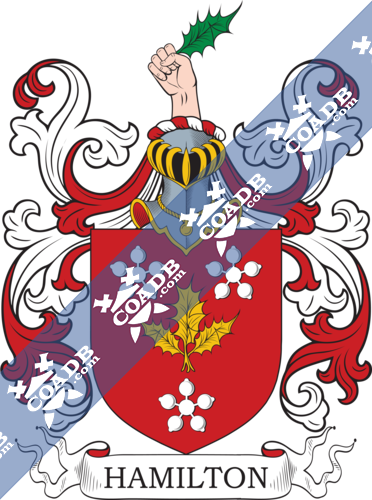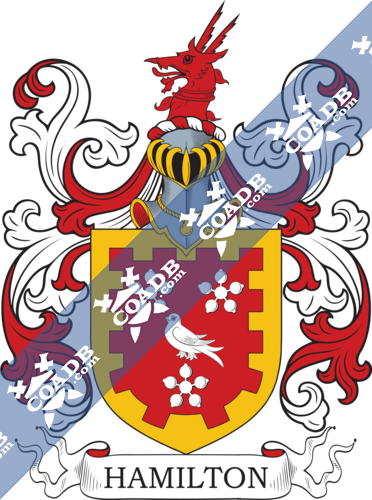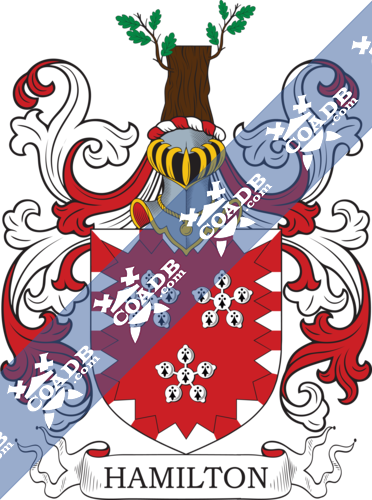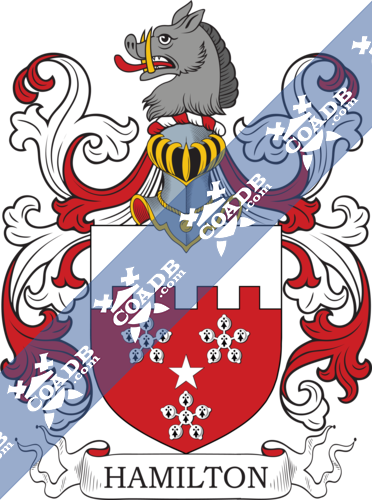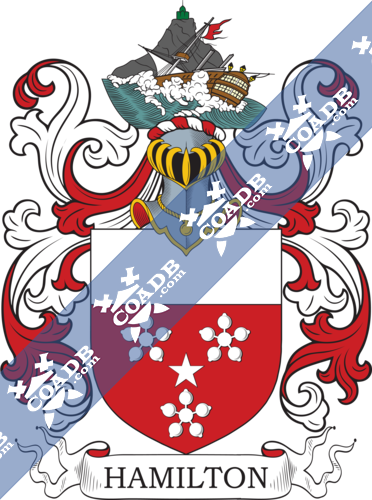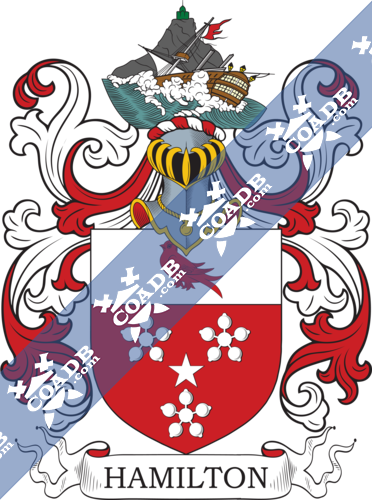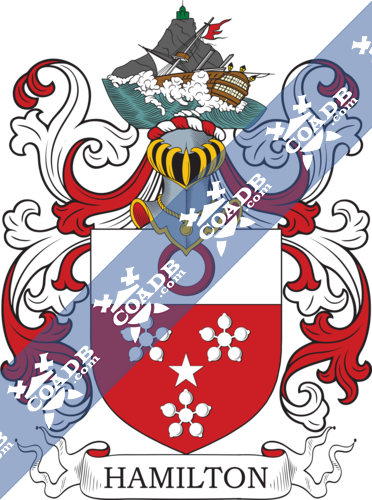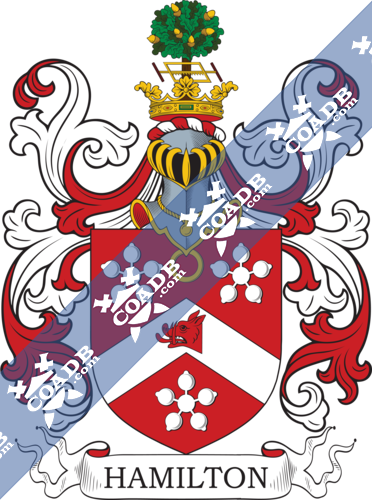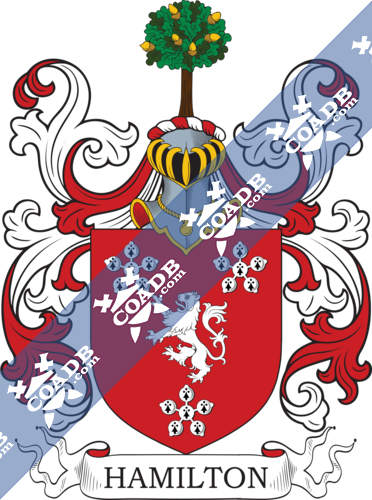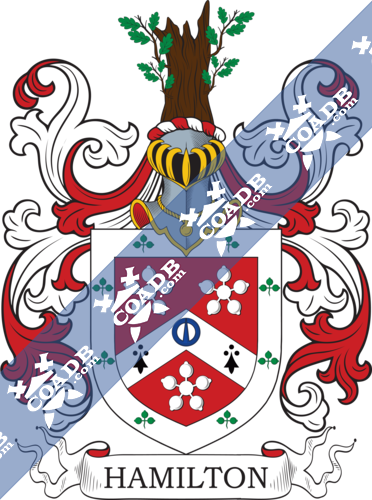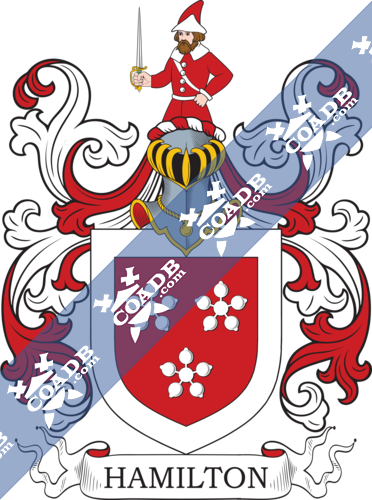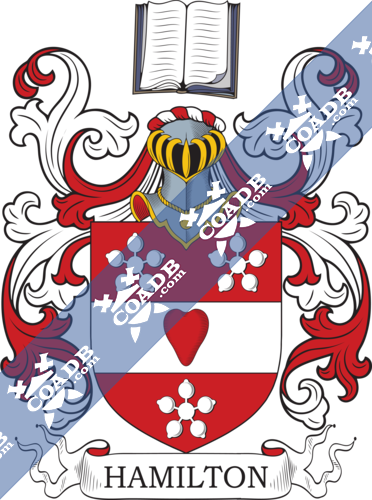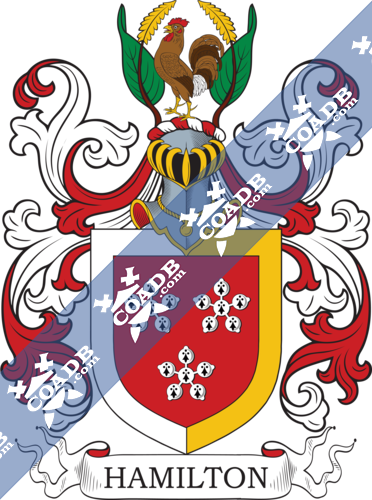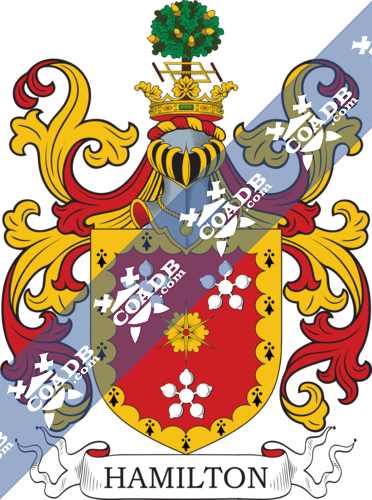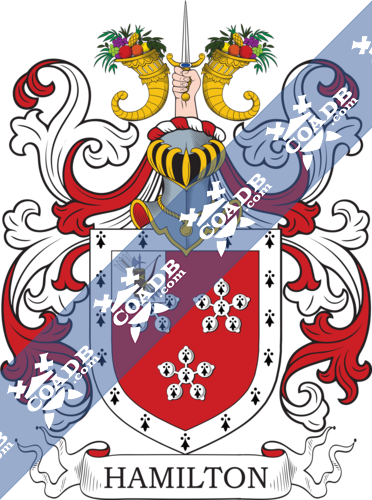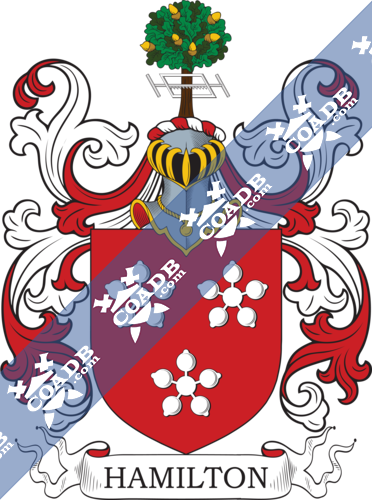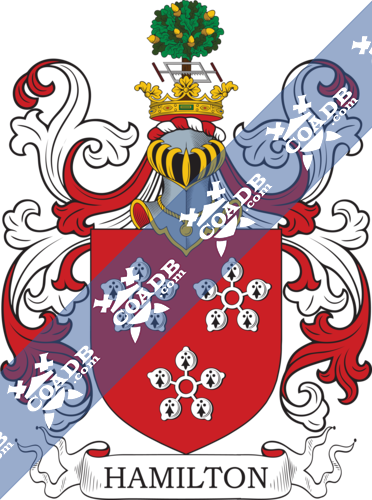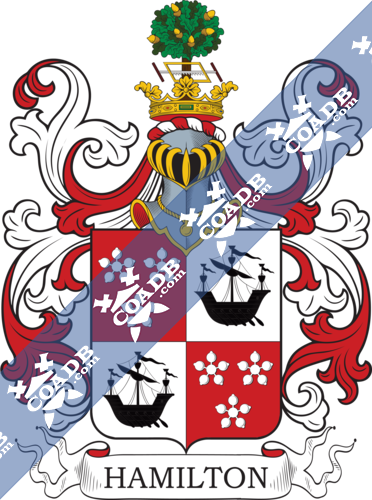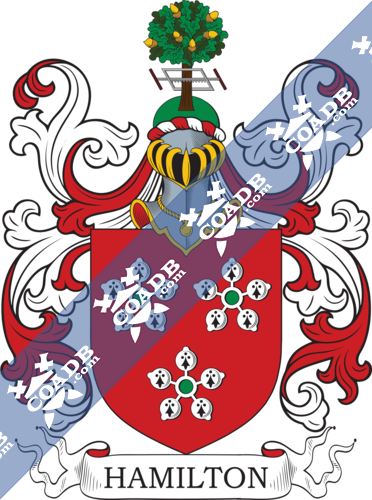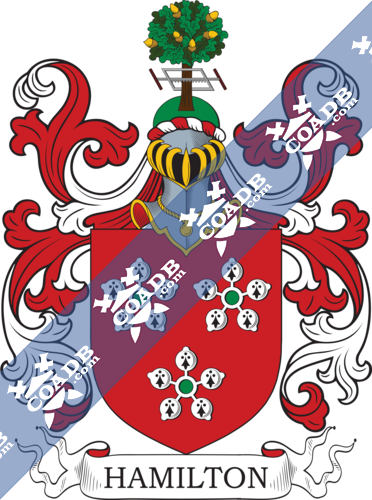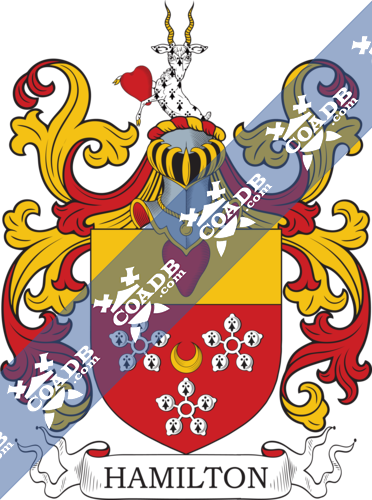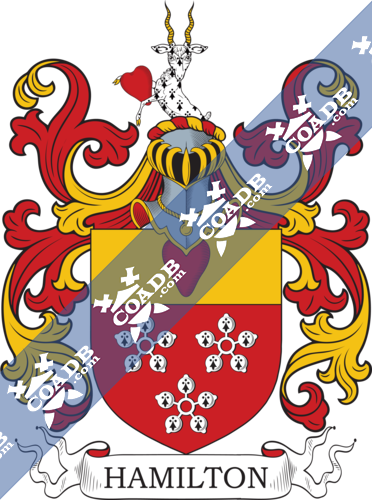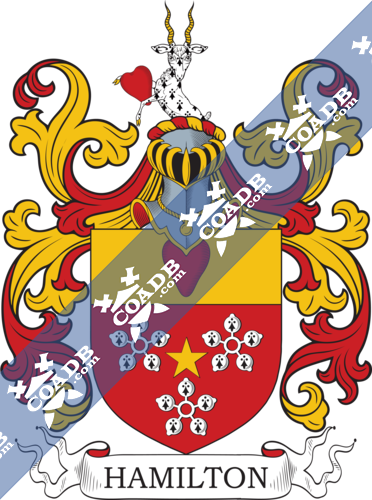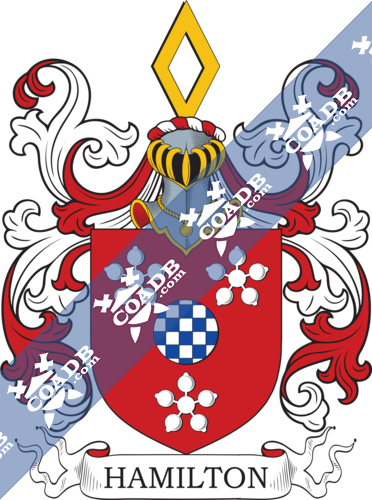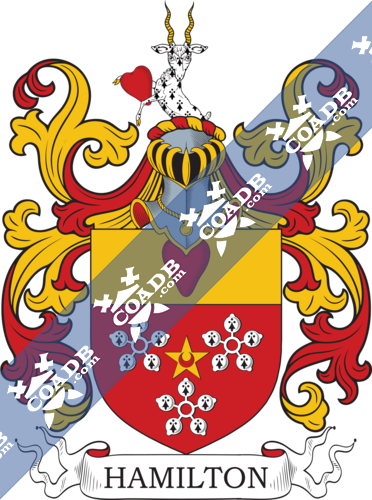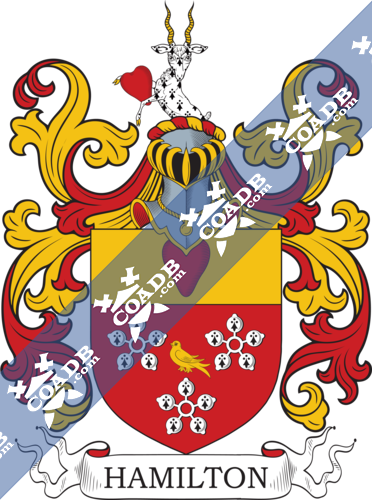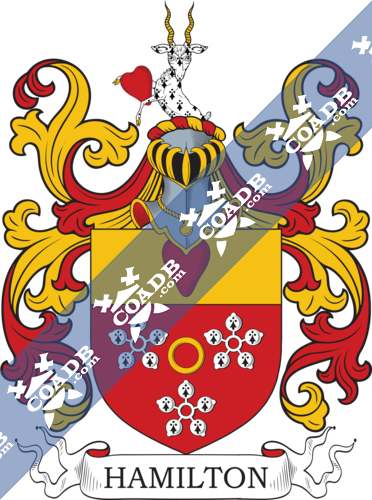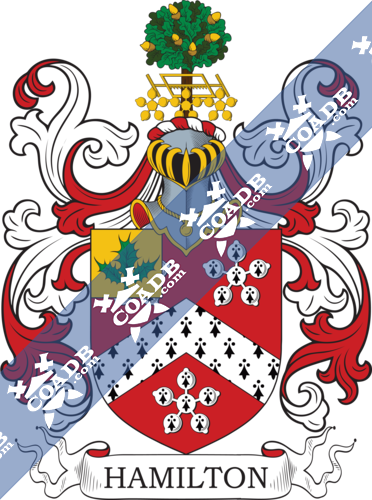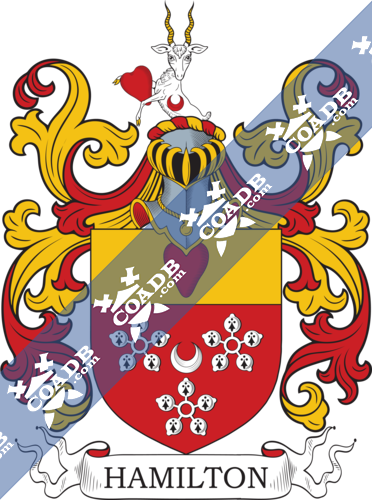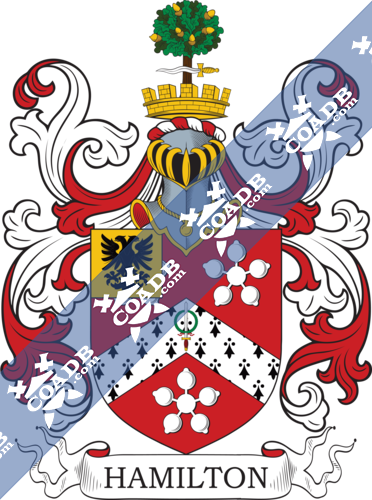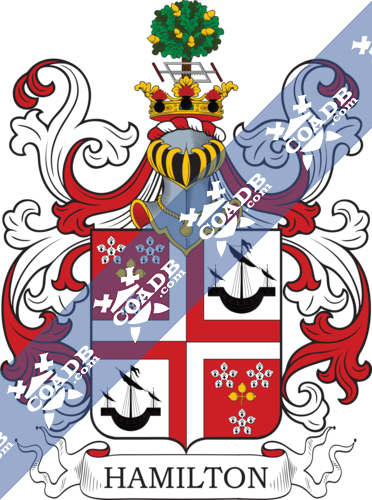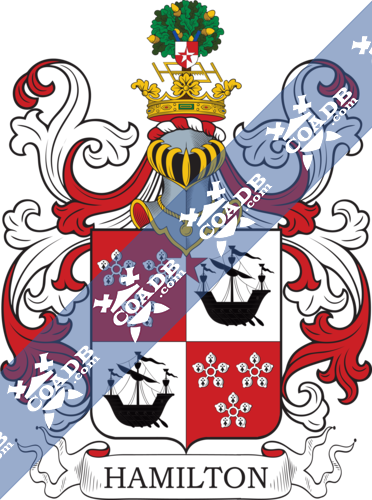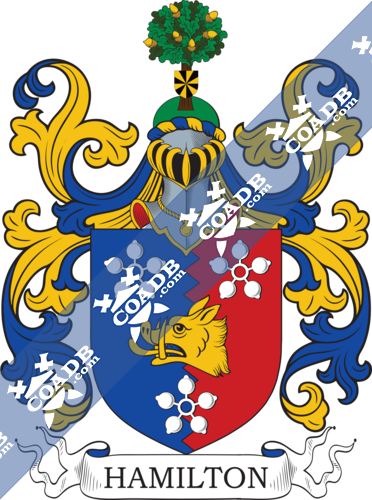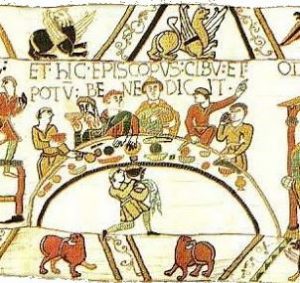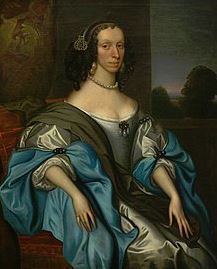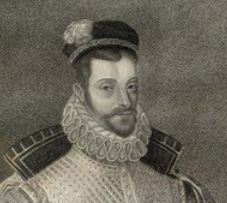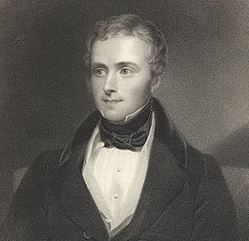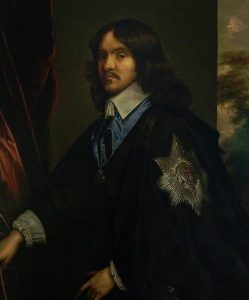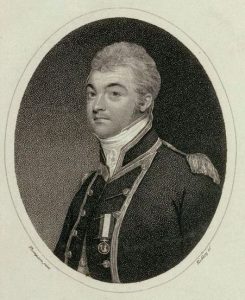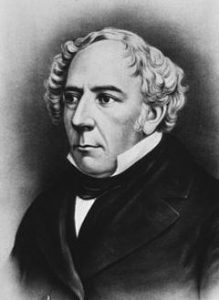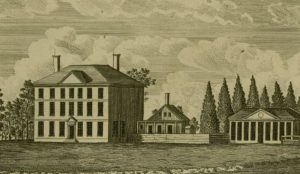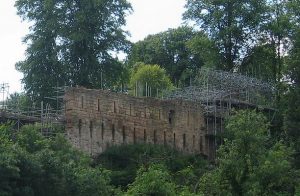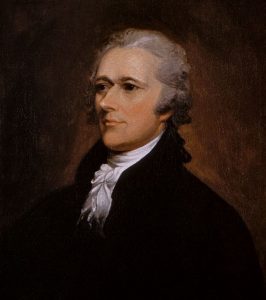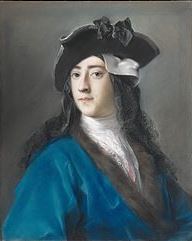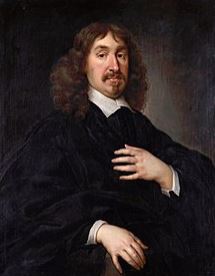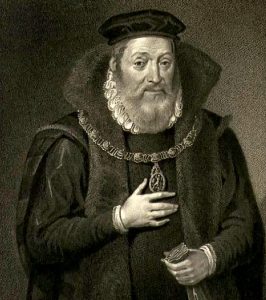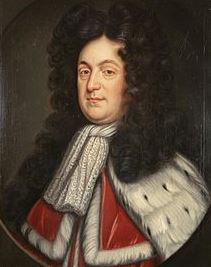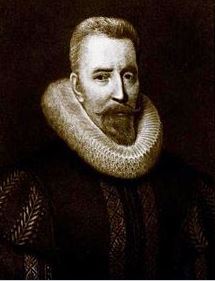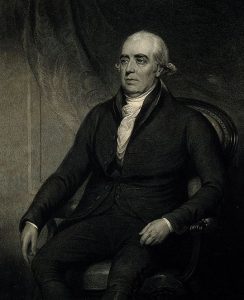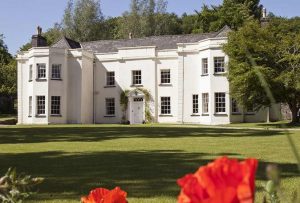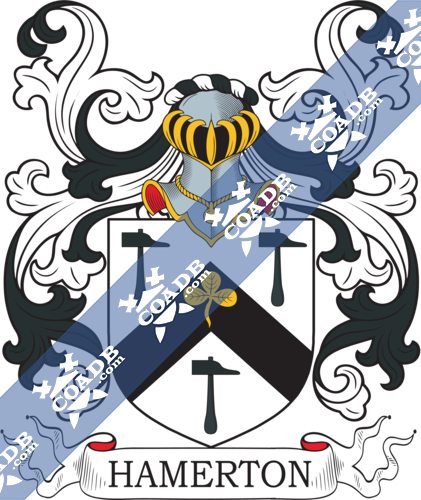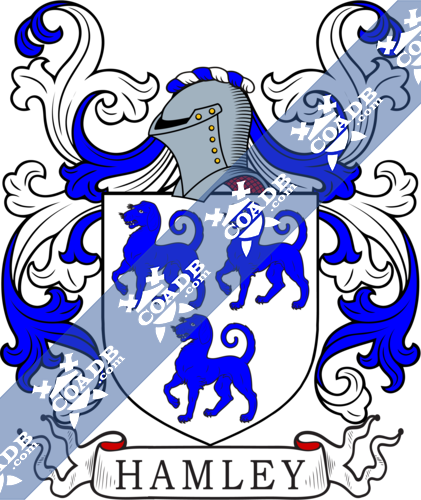Hamilton Family Crest, Coat of Arms and Name History
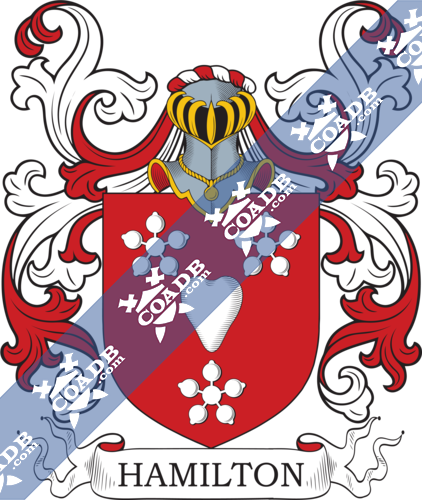
Hamilton Coat of Arms Gallery
Don’t know which Coat of Arms is yours?
We can do a genealogical research. Find out the exact history of your family!
Learn More
Hamilton Surname Name Meaning, Origin, History, & Etymology
According to The Dictionary of Surnames, authored by Basil Cottle in 1978, this last name is a locational name denoting someone who came from the village of Hamilton in Leicestershire, England, although the name became establish in Lanarkshire in the 1200s AD, where the town of Hamilton in South Lanarkshire was named after the family in the fifteenth century. According to A Dictionary of Surnames, authored by Flavia Hodges in 1988, most descendants of this family either descend from the original noble family or from the two aforementioned times. However, Another source, Charles Wareing Bardsley, in his 1901 book, A Dictionary of English and Welsh Surnames, states the Scottish Hamilton are traced back to Hambleton, a manor in counting Buckingamshire, and the English Hamiltons sprung from twelve different locales, including Hambleton, a township in the parish of Brayton, near Selby, in county York. He also mentions here are also several dioceses called Hambledon (ex. Petersborough, Oxford, and Winchester) and one called Hambleton (Manchester), as well as several smaller locales. The Dictionary of American Family Names, published in 2013, states this primarily Scottish and Northern Irish last name is a habitational name for someone who came from the village (now deserted) of Barkby, Leicesterhsire, and derives from the Old English word hamel (crooked or blunt) and dun (hill). Another source states hamell means the seat of a freeholder or mansion. Yet another source states the Old English word hamel means bare, treeless, or scarred. In Ireland, it could have replaced the surname Hamill in some instances, and is an Anglicized version of the Irish surname Ó hUrmholtaigh.
The family was first found in Renfrewshire, Scotland, where they received lands of King Robert the Bruce of Scotland (1274-1329 AD). The Clan trace its origins to the Earls of Mellent in Normandy who arrived in Britain with William the Conqueror during the Norman Invasion of 1066 AD, after which they were granted the lands of Hambleton in Buckinghamshire. One of the early ancestors, Sir William de Hambleton feuded with John de Spence and killed him, drawing the ire of King Edward II of England, and pursued him as he fled north to Scotland, where according to legend, Sir William exchanged clothes with a wood cutter, used their saw, and coat down a large oak tree to bridge a river, using it to escape, hence why many of the arms of the family depict a saw. William was the third son of Robert de Beaumont, 3rd Earl of Leicester, and founded the family around 1215 AD, taking the surname from the manor of Hambleton in Buckinghamshire, and was well received by King Alexander II of Scotland.
Another source states the family progenitor of the family was Walter fitz Gilbert of Cadzow, an Anglo-Norman companion of Robert the Bruce, and the family rose to power to be the leading noble family in Scotland, second only to the royal House of Stewart, to whom they were related.
In his book, Patronymica Britannica, Mark Antony Lower writes “The Hamiltons are a migratory race, and are to be found in almost everj’ region of the world. In the kingdom of Sweden alone, there are three noble houses of this name, descended from officers who served Gustavus Adolphus in the 30 years’ war”.
George Fraser Black’s 1946 book The Surnames of Scotland, states the following in regard to this last name: “The house of Hamilton was represented from 1294—95 to a date something short of 1346 by Walter Fitz Gilbert, the father of David, who styled himself on his seal David Fitz Walter, but who was more fully styled Sir David Fitz Walter Fitz Gilbert. Sir David was succeeded by his son of the same baptismal name who, in 1378, was the first of the house to style himself by his territorial title alone, David de Hamilton, although Walter had been described among the lairds of Renfrewshire as “Wauter fiz Gilbert de Hameldone” as early as the Homage Roll of 1296”.
Spelling Variations
Common spelling variants or names with similar etymologies include Hameldene, Hameldone, Hameldon, Hamelton, Hamildon, Hambleton, and Hamylton.
Popularity & Geographic Distribution
The last name Hamilton ranks 107th in popularity in the United Status as of the 2000 Census. The name ranks particularly high in the following seven states: Kentucky, Indiana, Ohio, Michigan, Missouri, Alaska, and Wyoming.
The surname Isaac frequency/commonness ranks as follows in the British Isles: England (130th), Scotland (36th), Wales (284th), Ireland (413th) and Northern Ireland (27th). In England, it ranks highest in Cumberland. In Scotland, the surname Hamilton rankest highest in Bute. In Wales, it ranks highest in Radnorshire. In Ireland, it ranks highest in Donegal. In Northern Ireland, it ranks highest in county Tyrone.
The name is also present throughout the remainder English speaking world: Canada (87th), New Zealand (101st), Australia (99th), and South Africa (805th).
Early Bearers of the Surname
The Hundred Rolls of 1273 AD, a census of Wales and England, known in Latin as Rotuli Hundredorum lists four bearers of this surname: William de Hameldene (Buckinghamshire), Robert de Hambeledene (Oxfordshire), Alexander de Hameldone (Buckinghamshire), and Thomas de Hameleden (Gloucester). Richard de Hameleden was documented in county Surrey during the era of King Henry III and Edward I of England in the Testa de Neville, sive Liber Feodorum. Robert Hameldon, parson of the church, was recorded in county Surrey in 1292 AD in the Placita de Quo Warranton. Gilbert de Hameldun, clericus, was one of the witnesses to a charter by Thomas de Cragyn to the monks of Paisley, 1272. Walter Fitz-Gilbert was witness in 1294—95 to a charter of the manor of Blackhall in Renfrewshire by James the High Steward to the same monks (ibid., p. 96), and in 1296 he rendered homage as Wauter fiz Gilbert de Hameldone.
Hamilton Family Tree & Hamilton Genealogy
There are at least 23 noble/aristocratic branches of the Hamilton family tree or lineage. Each will be discussed in some detail below.
Hamilton of Cairn Hill and West Port
The Hamilton family genealogy traces back to William Hamilton, son of Alexander of Silvetonhill, who was the first of Westport. William was succeeded by his son John. John left a son named James. James married Anna, daughter of Sir Patrick Hamilton, of Little Preston. The eldest son of this marriage died in battle and their eldest daughter married Walter Sandilands (son of William Sandilands of Hilderston and Elizabeth Cunninghame). The title of Cunninghame Head having, with that of Ruthven, become extinct in the male line, in the person of Sir William, 10th of Cunninghame Head. The eldest son of the above marriage was Sir James Sandilands Hamilton, who assumed the Baronetcy. He did in 1733 without issue, and was succeeded by his brother, Sir Walter Sandilands Hamilton, a Captain in the army, who served thirteen campaigns under Marlborough. Sir Walter married his cousin Helen, daughter of Thomas Hamilton of Olivestob, and had two sons (who died without having posterity) and daughters. The eldest daughter was Grizel Hamilton, the heiress of Westport, who married John Ferrier, Esq. of Kirkton and had four sons with her: William (his heir), Walter (of Glenfuir, married Lillias Wallace, had five children), James (Principal Clerks of Session, married Miss Coutts, had issue), and Hay (Major-General, Governor of Dumbarton Castle, married Jane, only child of John Macqueen, and later Agnes Cutlar). The eldest son and her was William Ferrier Hamilton, Esq. of Westpool, who was a Lieutenant in the Royal Navy, involved with the capture of Quebec. He died without posterity and was succeeded by his nephew, Colonel John Hamilton of Cairnhill and Westport, a Justice of the Peace and Deputy Lieutenant born in 1786. In 1817, John married Georginia, daughter of Charles, 2nd Viscount Gort, and had issue with her as follows: Walter Ferrier (his heir), Charles Vereker Hamilton Campbell (of Netherplace, assumed the surname Campbell on succeeding the estate of Netherplace, an ancient cadestship of the Loudon family, married Mary Sancroft), Thomas Wallace (married Bessie Stephens), John Prendergast (married Agnes Buchanan), William Archibald (Captain in the Ayrshire Rifles), Jane Lillias (married Andrew Dillan of Wallhouse), Julia Mary (married George Oswald), and Georgina Vereker. He fought in the Peninsular Campaign and received a war medal and three clasps for his service. He died in 1871 and was succeeded by his eldest son, Walter Ferrier Hamilton, Esq. of Cairnhill and Westport, who was born in 1818. Watler was a Captain in the army and a Member of Parliament for Linlithgow. He married Barbara Agnes, daughter of James Marshall, and died in 1872, leaving two children: John Wallace and Francis Sandilands. His son John Wallace Hamilton, Esquire of Cairn Hill in county Ayr, and Westport, county Linlithgow, was born in 1863. The Hamilton Coat of Arms (erroneously called the Hamilton Family Crest) is blazoned in heraldry as follows: Quarterly; 1st and 4th, gules, three cinquefoils ermine, within a bordure argent, charged with eight martlets of the first, for Hamilton; 2nd and 3rd, gules a lion rampant argent within a bordure argent and azure, for Wallace. Crest: Two branches of oak crossing each other in saltire. Motto: Addunt robur stripi.
Hamilton of Craighlaw
The ancestry of this branch of the Hamilton family tree traces back to John Hamilton, of Ladyland, who succeeded his father in 1690, and sold the property to Alexander, 9th Earl of Eglinton, and went to the north of Ireland and purchased an estate there. He married, Margaret, daughter of Sir John Shaw, Baronet of Greenock and Jane Mure, and had numerous issue with her. His eldest son was William Hamilton, Esquire, sold his Irish property and returned to Scotland, where he purchased Craighlaw, county Wigton. He married Isabella, daughter of McDowal of Logan, but did not have children. His brother, Charles, Esquire of Craighlaw, married Sarah, daughter of McDowal of Logan as well, and had several issue with her. He dided in 1783 and was succeeded by his son William Hamilton of Craighlaw, M.D., who married Agnes, daughter of Edward Cairns of Girstonwood, and had issue with him, including a daughter named Catherine (married William Cochrane of Ladyland) and an only son, William Charles Hamilton, Esquire of Craighlaw, Justice of the Peace and Deputy Lieutenant, Captain in the army who served at Waterloo. He was born in 1794 and in 1825, he married Anne, daughter of Reverend A. Stewart, and had issue with her, including a son named William Charles Stewart of Craiglaw who was Justice of the Peace and Deputy Lieutenant and was born in 1831. In 1863, he married Margaret Anne Mary, daughter of Thomas Jones of Hinton Charter House, having two issue with her: Malcolm Fleming and Maude Blanche. His son Malcolm Fleming Hamilton, Esq. of Craighlaw, county Wigton, was born in 1869 and succeeded his father in 1876. The Hamilton Coat of Arms (erroneously called the Hamilton Family Crest) is blazoned in heraldry as follows: Gules, a mullet between three cinquefoils all within a bordure wavy argent. Crest: On waves of the sea a dolphin in chase of flying a fish all proper.
Hamilton of Killyleagh
The Hamilton genealogy traces back to a house of Hamilton that springs from the same stock as the Earls of Clanbrassil and Viscounts Limerick. Reverend Hans Hamilton, Vicar of Dunlop, was born in 1536, who in 1536, married Margaret Denham, daughter of Laird of Weshields, and died in 1608, leaving the following five sons: Sir James (of Killyeagh and Banjor, Serjeant-at-Law, and Privy Councillor to King James I, was created Viscount Claneboe, had son named James, who was created Earl of Clanbrassil), Archibald, Gawen (of Ballygally, married Helen Dunlop and had several issue with her), John (on Coronary, county Cavan and Monsella, county Armagh, ancestor of the Hamiltons of Abbotsdown), and William (of Bangor, county Down, ancestor of the Hamiltons of Bangor, Tollymore Park). His son Archibald was Esquire of Halcraigh, Denham, county Lanark, married Rachel Carmichael and had five sons with her: John, James (of Neilsbrook, county Antrim, inherited one fifth of the Early of Clanbrassil’s estates, married Agnes Kennedy, had three daughters), Gawen, William (of Killyleagh), and Hugh (of Dublin, a merchant). He later married again and had a daughter named Jane, who married Archibald Edmonstone of Braiden Island. His third son, Gawen Hamilton, was Esquire of Killyeagh who married Jane, daughter of Archibald Hamilton, and died in 1703. He was succeeded by his son, Archibald Hamilton, who married Mary, daughter of David Johnstone of Tully, and had the following children with her: Gawen (his heir) and William (of Killough, married Elizabeth Caddell. The elder son, Gawen, was born in 1729 and in 1750, he married Jane, daughter of William Rowan, with whom he had two childnre: Archibald and Sidney (married Reverend Benjamin Beresford). His heir, Archibald Hamilton Rowa, was Esquire of Killyleagh Castle who was born in 1752. In 1781, he married Sarah Anne, daughter of Walton Dawson of Carrickmacross, and had nine issue with her: Gawen William (office in the Royal Navy, married Catherine Cockburn, had three issue), Sydney (married daughter of Henry Jackson of Carrickmacross), Archibald (officer in the army, died at Gibraltar), Frederick (Royal Navy, killed on the Coast of Spain in 1811), Dawson, Jane, Elizabeth (married Reverend Sidney Beresford), Mildred (married Sir Edward Ryan), Harriet (married Crofton Fitzgerald), Francesca (married William Fletcher). He died in 1834 and was succeeded by his grandson, Archibald Rowan Hamilton, Esquire of Killyleagh Castle, county Down, Justice of the Peace, High Sheriff, Captain 5th Dragoon Guards, born in 1818. In 1842, he married Catherine Ann, daughter of Reverend George Caldwell, and had issue with her: Gawen William Rowan, George Rowan (Justice of the Peace, Lieutenant 8th Foot, Adjutant Royal North Down Militia, married Helen, daughter of J. Maudslay of Kensington), Sidney Augustus Rowan (Lieutenant of Royal Navy), Frederic Temple Rowan (A.D.C., 9th Regiment), Harriot Georginia (married Earl of Dufferin), Helen Gwendoline (married Russell Maul Stephenson), and Mary Catherine. His son Gawen William Rowan Hamilton, Esquire of Killyleagh Castle, county Devon, was born in 1844. He was Justice of the Peace, Deputy Lieutenant, High Sheriff in 1875, Major of the R.N. Down Rifles, and a Captain of the 7th Dragoon Guards. In 1876, he married Lina Mary Howley, daughter of Sir George Howland Beaumount, Baronet of Coleorton, and had a son with her named Archibald James, born in 1877. The Hamilton Coat of Arms (erroneously called the Hamilton Family Crest) has the following heraldic blazon: Gules, three cinquefoils pierced ermine on a chief or, a heart of the first. Crest: A demi-antelope argent attired or, holding between the forelegs a heart gules.
Hamilton of Abbotstown
The Hamilton ancestry of this branch of the Hamilton family tree traces back to John Hamilton, Esq. of Conorary, county Can and Monella, county Armagh, son of Reverend Hans Hamilton. In 1617, he married Sarah, daughter of Anthony Brabazon of Ballinasloe, and had four sons with her. The second son, James, was an Esquire of Bailieboro in county Cavan, who in 1639, married Jane, daughter and heir of William Baillie, Bishop of Clonfort, and had issue with her. His eldest son was Henry Hamilton, Esq. of Bailieboro, who was killed at Limerick, but who married Miss Blackwell, and had issue named James (heir heir), John (of Holmpatrick, Member of Parliament), and Mary (Mrs. Ligoe). His son and heir was James, Esquire, a Member of Parliament for Carlow, who married Anne Hall, and had children with her: Hans (of Carlow and Summer Hill, Dublin), James, John (of Straw Hill), Elizabeth (married Frederick Faulkner of Abbotstown), Rebecca (married Christopher Dominick), Margaret (married Henry Hamilton), Anne, Jane, and Sophia. His second son, James Hamilton, Esq. of Sheephill and Holmpatrick, county Dublin, was Deputy Prothonotary of the Court of King’s Bench, who married Hannah Phillips and had issue with her: Hans (his heir), Henry (of Ballymacoll, Meath, married Mary Wetherall, had five daughters and five sons), James (of Dunboyne Castle, had four issue), John (of Hackerstown, Dublin, married Eliza, daughter of Sir William Alexander, Baronet of Dublin), Robert (of Clonsilla, married Catherine, daughter of Sir William Alexander, Baronet, had eight children), Francis (of Dublin, Ireland, married Rebecca, daughter of Colonel William Reynell and had six issue), Charlotte (married Robert White), Caroline (married Thomas Stannus), Elizabeth (married William, son of William Irvine, Esq. of Castle Irvine), Mary (married Thomas, son of Charles Henry Hendrick), Sophia (married Richard Jones of Dollardstown), and Margaret (married Henry Johnson). He later married Alice, daughter of John Hamilton (Esquire of Derry), and had five children with her: Charles, Reverend Richard (Rector of Culdaff and Cloncha, married Catherine, daughter of Edward Tipping), Christopher (Major General in the 97th Foot, married Hon. Sarah Handcock), Emily, and Harriett. He later married Miss Jane Candlir. It is said with all three wives combined, he had a total of 36 children. His eldest son was Hans Hamilton, Member of Parliament, for county Dublin, who married Sarah, daughter of Joshua Lynam, and had two daughters with her: Sarah (married George Woods) and Jane (married Michael Law). He later married Anne, daughter of Hugh Henry Mitchell, Esq. of Dublin, and had five issue with her: James Hans, Elizabeth (married Robert Law), Anne, Frances (married Richard Howard Brooke), and Harriet (married Robert Clayton Browne of Browne’s Hall). His eldest son was James Hans Hamilton,Esquire of Abbotstown and Holmpatrick, who was a Deputy Lieutenant, Justice of the Peace, and Member of Parliament for Dublin who was born in 1810. In 1833, he married Caroline, daughter of John F. Durant of Dovea, county Tipperary and Caroline Brooke, and had two issue with her: Hans James (born 1835) and Ion Tront. Ion-Trant Hamilton, Esquire of Abbotstown and Holmpatrick, county Dublin, was Justice and Peace, Deputy Lieutenant, and Member of Parliament for that county. He was born in 1839 and in 1877, he married Victoria Alexandria, daughter of Major General Lord Charles Wellesley. The Hamilton Coat of Arms (erroneously called the Hamilton Family Crest) has the following heraldic blazon: Gules, three cinquefoils ermine, on a chief or, a lion passant of the first, a mullet charged with a crescent for diff. Crest: A demi-antelope ermined, attired or, holding between forelegs, a human heart gules. Motto: Qualis ab incepto.
Hamilton of Dalzell
The discussion of the Hamilton genealogy or lineage begins with Gavin Hamilton, 4th son of Sir James Hamilton, from who derive the ducal Houses of Abercorn and Hamilton, who was the progenitor of this family. He lived during the reigns of King James II and James III of England, and in 1420, he married Jean Muirhead, known as “the fair maid of Lechbrunnock”, from the House of Lauchope, with whom he had the following children: Robert (Chancellor of Glasgow), Thomas, John (successor to Orbistoun), Archibald, and Gavin (ancestor of the family of Haggs). His son, John Hamilton, the first designated by the title of Orbistoun, married Jean, daughter of Hamilton, of Woodhall, with whom he had issue: Gavin Hamilton, of Orbistown. Gavin was named one of the heirs of entail in a Deed of Settlement executed by the first Earl of Arran. He was named one of their heirs of entail in a settlement of the Hamilton estates by the Duke of Chatelherault, in 1540. He married Helen, daughter of Wallace of Cairnhill, and had issue. Gavin’s eldest son was John Hamilton, of Orbistoun, accompanying the Queen along with his kinsmen, to the battle of Lanside, where he died. He married Margaret, daughter of Hamilton of Haggs, and had issue. His eldest son was named John. John married Christian, daughter of Robert Dalzell, ancestor of the Earls of Carnwath, and had issue with her: John, James, Marion (married James Hamilton of Bangour), and Margaret (John Walkinshaw). His son and heir was Sir John Hamilton, Lord Justice Clerk, whose male line expired with his grandson, William Hamilton, of Orbistoun and Erkine. John’s second son was James. James acquired Dalzell from his uncle, Sir Robert Dalzell, 1st Earl of Carnwath, and he married Jean, daughter of Sir John Henderson of Fordell. He was succeeded by his eldest son Alexander Hamilton, of Dalzell, who had a charter of the lands and barony of Dalzell in 1671. He married Bethia, daughter of Sir William Henderson of Fordell, and had issue with her. His son James, in 1693, married Margaret, daughter of Sir Archibald Hamilton, Baronet of Rosehall, and had children with her. His eldest son was Archibald Hamilton, of Dalzell, Orbiston, and Rosehall, who in 1732, married Marion, daughter of Hugh Dalrymple of Dromore, and had issue with her prior to his death in 1774. The eldest son of this marriage was James, who was born in 1733, and died in 1814, whereupon he was succeeded by his brother, John, of Dalzell and Orbison, who was born in 1741. John was a General in the army and he married Anne Mathews, with whom he had three issue, prior to his death in 1834: Archibald James (born 1793, office in the army who served in the Peninsular War, and in the Scots Grey at Waterloo, married Margaret Sibella Ramsay, later married Ellinor Hamilton), Robert (1796), and Marion (married Lieutenant Colonel David Rattray). John Glencairn Cater Hamilton, , son of Archibald James, was Esquire of Dazell, county Lanark, and was Justice of the Peace, Deputy Lieutenant, and Vice-Lieutenant of Lanarkshire, Captain of the 2nd Life Guards, Major of the Queen’s own Glasgow and Lanarkshire Yeomanry, and a Member of Parliament for South Lanarkshire and Falkirk Burghs, who was born in 1829. In 1864, he married Lady Emily Eleanor Leslie Melville, youngest daughter of David, Earl of Leven and Melville, and had seven issue with her: Archibald John, Gavin George, Leslie, Ellinor, Alice Susan, Helena Mabel, and Adele Emily Anna. The Hamilton Coat of Arms (erroneously called the Hamilton Family Crest) is blazoned in heraldry as follows: 1st and 4th, gules, an annulet or, between three cinquefoils ermine, for Orbistoun; 2nd and 3rd, gules, a mullet argent between three cinquefoils ermine, on a chief of the second a rose of the first, for Rosehall. Supporters: Dexter, an antelope proper gorged with a ducal coronet and a chain thereto hanging or; sinister, a savage proper wreathed head and middle with laurel, holding over the sinister shoulder a club or. Crest: An antelope proper, armed and unglued or. Motto: Quis occursabit.
Hamilton of Holyfield
Robert William Hamilton, Esquire of Holyfield Hall, Essex, was Lieutenant-Colonel of the Grenadier Guards, as well as Justice of the Peace for county Essex, England, who was born in 1833. In 1856, he married Charlotte Maria, only daughter of Colonel Palmer, of Nazing Park, Essex, had three issue with her: Ronald William, Mary Geraldine, and another daughter. Colonel Hamilton served in the Crimean campaign. He is the male representative, through his second marriage, of William Hamilton, 2nd of Wishaw, ancestor of Lord Belhaven. This family was seated at Holyfield Hall, Woodford.
Hamilton of Sundrum
John Hamilton, Esquire of Sundrum, county Ayr, Member of Parliament and Deputy Lieutenant, who was born in 1806, and in 1845, married Katharine Barbara, daughter of William Stobart Esq. of Picktree, county Durham, and had four issue with her: John, John Claude Campbell (married Marion Arkwright, daughter of Reverend E.C. Evans), Lewis Boswell Inman, and Mary Christian Dundas. The lineage of this branch of the Hamilton family tree traces back to Robert Hamilton, Bailie Clerk of Carrick, and Janet Blackwood, daughter of Robert Blackwood, who were admitted to the lands of Clongall. Hugh Hamilton, of Clongall, now called Glengall, was a merchant in Ayr, who married Jean, daughter of John Ferguson of Castlehill, and had seven daughters and three sons with her: Robert (of Bourtree Hill, married Jean Mitchell, heiress and widow Major Garth), John, and Hugh (ancestors of the Hamiltons of Pinmore). His son John, born in 1702, was an Esquire and served in the Royal Navy. He settled in Jamaica where he possessed the estate of Pemberton Valley. In 1739, he married Margaret, daughter of Hugh Montgomerie of Coilsfield, having a son with her named John. This John Hamilton, of Sundrum, in 1762, married his cousin, Lilias, daughter of Alexander Montgomerie of Coilsfield, with whom he had several daughters and seven sons: John (his successor), Alexander West (succeeded to Pinmore), Robert, Hugh (Lieutenant Colonel), Archibald (of Carcluie and Rozelle, Captain E.I.C’s naval service, married Jane, daughter of Hugh, the 12th Earl of Eglington), Thomas Bargany, and Montgomerie (Captain in the E.I.C’s naval service, married Anne Dundas). He died in 1821 and was succeeded by his son John, who was born in 1764 and entered in the Royal Navy, commanded the Combat Castle. In 1804, John married Christian, eldest daughter of George Dundas, Esq. of Dundas, and had fourteen children with her as follows: John (mentioned at the beginning of this paragraph), George Dundas (1811), Alexander (of Rozelle, Commander in the Royal Navy, married Mary Moorhouse Walters), Archibald, James (Captain in E.I.C. Bombay Artillery, married Katharine Arabella, daughter of Reverend Edward Warren Caulfield of Beechingstoke), Hugh (married Margaret Innes), Christian (married Charles Sterling of Gargunnock), Lilias, Margaret, Lilias, Anna Maria (married Captain Charles Acton Broke and later Captain William Horton), Margaret (married the Honorable Thomas Preston, son of Viscount Gormanston), Mary Dundas (married John Reginald Howison Craufurd of Craufurdland Castle), and Jane Hamilia (married Henry Spencer Helmington). The Hamilton Coat of Arms (erroneously called the Hamilton Family Crest) is blazoned in heraldry as follows: Gules, three fleur-de-lis in fesse or, between as many cinquefoils argent. Crest: An oak tree fructed, penetrated transversely in the main stem by a frame-saw proper. Motto: Through.
Hamilton of Beltrim
The ancestry/lineage of this branch of the Hamilton family tree traces back to Sir Claud Hamilton of Baldoney, county Tyrone, the son of Claud, 1st Lord Paisley, who married the daughter and heir of Sir Robert Hamilton of Manor Elieston, county Tyrone. He died in 1629, leaving five sons: Alexander, Robert, George, Claud, and James, and William. His son, Sir William Hamilton, Knight of Manor Elieson, county Tyrone married twice and had issue. The eldest son of his second marriage (with Beatrix Cambell) was Claud Hamilton, Esq. of Montaloney, who married a woman named Isabella and had the following children with her: Beatrix, Mary, Agnes, Margaret, William, and Claud (of Straborne, ancestor of Hamilton, Baronet of Woodbrook). He was succeeded by his eldest son William, Esquire of Beltrim in county Tyrone, who married a woman named Mary and had two sons and three daughters. His last surviving son was Claud, who married his cousin, Letitia, daughter of Claud Hamilton of Strabane, with whom he had three daughters: Letitia, Isabella, and Beatrix. He was succeeded by his daughter, Letitia, who in 1780, married Arthur Cole of Skea, a Member of Parliament and High Sheriff, and had four children with her: Claud William, Letitia (married Major Stafford), Elizabeth Ann (married Henry Slade), and Isabella (married James Hamilton). Arthur Cole adopted the additional surname of Hamilton and was succeeded by his eldest son, Claud William Cole, of Beltrim, who was High Sheriff in 1811 and was born in 1871. He married Nicola Sophia, daughter of Richard Chaloner, of Kingsort, with whom he had two sons: Arthur Willoughby and Richard (of Kingsfort, county Meath, who adopted the additional surname Chaloner, married Harriet Tisdale). His son Arthur Willoughby Cole-Hamilton, Esquire of Beltrim, county Tyrone, was Justice of the Peace, Deputy Lieutenant, High Sheriff in 1830m, and a Major of the Royal Tyrone Fusiliers Militia, born in 1806. In 1831, he married Emily Katherine, daughter of Revered Charles Cobbe Beresfrd, grand daughter of Honorable John Beresford, and had the following issue with her: William Claud (late Captain 80th regiment, was born 1833, married Caroline, daughter of Andrew Godfrey Stuart), Claud (married Henrietta Ann, daughter of Alexander Montgomery), Charles Richard, Reverend Henry Arthur (Rector of Scaldwell in Northampton, married Harriet Elizabeth, daughter of John Tisdal of Charlesfort), John Isaac, Emily Harriet (married John Gordon Brown), Frances Sophia, Selina (married Robert George Gaussen of Brooksman Park), and Letita Grace (married Henry George Louis Crichton). The Hamilton arms are blazoned as follows: Quarterly, 1st and 4th, quarterly, 1st and 4th, gules, three cinquefoils pierced ermined, 2nd and 3rd, argent a ship with sails furled and oars sable; 2nd, argent, a bull passant sable armed and ulguled or, a border of the second charged with eight bezants on a sinister canton per pale gules and azure a harp hold, stringed of the field, 3rd; sable, a chevron between three cherubim or. This family was seated at Beltrim Castle, Newton Stewart, county Tyrone, Northern Ireland.
Hamilton of Castle Hamilton
James Hamilton, Esquire of Castle Hamilton, county Cavan, was Justice of the Peace, Deputy Lieutenant, and High Sheriff in 1847. In 1843, he married his cousin, Mary Matilda, daughter of Thomas Dickson of Grangeville, and had seven children with her: James, William Joseph, Robert Claude, Anna Elizabeth, Elizabeth Matilda, Mary Catherine, and Maude Victoria. He procured Castle Hamilton in 1844, from Robert Henry Southwell. The lineage of this traces back to Galbraith Hamilton of Morefield, county Tyrone, son of William, the first settler in Ireland from this branch of the House of Hamilton. Galbraith married a member of the Douglas family, and had four children with her: William, Archibald (married Anne), Captain James (killed at Almanza), and Hans (of Frankfort, married Margaret). His eldest son was William, Esq. of Ballyfatton, near Strabane, in couny Tyrone, who was a Cornet in the army. In 1793, he purchases lands in the area and had three children: Archibald, Charles (son James), and Galbraith. The eldest son, Archibald Hamilton, Esquire of Ballyfatton, married Jane, daughter of Revered George Nesbitt of Drumalough, with whom he had the following issue: William (his successor at Ballyfatton, married Miss Mary White of White Hall), George, Katharine, Sarah (married John Frederick). He later married Letitia Fairlie and had further issue with her: Archibald (M.D., of Dublin), Richard (died in Jamaica), Galbraith, Sampson, Margary (Colonel Paumien), and Letitia. He was succeeded by his son, Galbraith Hamilton of Dublin, who married and had the following issue: James, John (of Larkfield, married Jane Dickson, had James, mentioned at the beginning of this paragraph), Matilda, (married George Maconchy, Esquire of Rathmore, county Longford), and Mary Ann.
Hamilton of Hampton Hall
This family claims descent from a son of Sir James Hamilton, of Evandale, and has been operating in Ireland since the 1600s AD. Hugh Hamilton of Lisbaane near Bangor, county Down, was a Scottish settler in Ireland during the reign of King James I of England. He had three sons: John (of Ballymenoch, near Hollywood and of Bally Verne), Alexander, and Robert (married Jane Phillips). His son Alexander Hamilton of Killyleagh married Jean Hamilton and was the father of Hugh. Hugh, Esq. of Ballybranagh, married Mary, daughter of George Ross of Rosstrevor and Ursula Hamilton, and had two sons with her: Alexander (his heir) and George (of Tyrella, married Elizabeth Echlin). His eldest son was Alexander, who was a Member of Parliament of Knock in county Dublin, and Newtown Hamilton in county Armagh. Alexander married Isabella, daughter of John Maxwell of Finnebrogue, and had three daughters and the following four sons with her: Hugh (of Newton Hamilton, Dean of Armagh, Bishop of Clonfert, married Isabella Wood, had several issue), Robert (married daughter of Jonathan Chetwood of Woodbroke, had two sons), George, and Charles (of Hamwood, county Meath). His third son, the Honorable George Hamilton, Member of Parliament, Baron of the Exchequer of Hampton Hall, was Member of Parliament for Belfast and was raised to the Bench in 17765. George married his cousin, Elizabeth, daughter of George Hamilton, and had issue with her. He died in 1793 and was succeeded by his son Alexander Hamilton, a Member of Parliament for Belfast, who married Catherine, daughter of Thomas Burgh, having issue with her. He died in 1808 and was succeeded by his brother, Reverend George Hamilton of Hampton Hall, who in 1796, married Anne, daughter of Thomas Pepper, and had three children with her: Right Honorable George Alexander (his heir), Thomas Claud George (Justice of the Peace, married Gertrude Anne Uhthoff), and Harriet (married Joseph W. Swan of Kingstown). He was succeeded by his son, Right Honorable George Alexander Hamilton, of Hampton Hall, county Dublic, who was a Justice of the Peace, Deputy Lieutenant, Member of Parliament, and Assistant Secretary of the Treasury, born in 1802. In 1835, he married Amelia Fancourt, daughter of Joshua Uhthood of Bath. He died in 1852. Henry Alexander Hamilton, Esquire of Hampton Hall, county Dublin, was Justice of the Peace, county Meath and county Dublin, born in 1820. This branch of the Hamilton family tree was seated at Hampton Hall, Balbriggan, Ireland.
Hamilton of Hamwood
The Hamilton genealogy traces back to Charles Hamilton, Esquire, son of Alexander of Knock and Isabella Maxwell. He was of Hamwood, county Meath, Ireland and of Bishopstown and Clare, county Westmeath, and he married Elizabeth, daughter of Crewe Chetwood of Woodbrook and Anna Holford, having six children with her: Charles, Robert (of Liverpool, merchant), George (of Quebec and Hawksbury, Canada, Colonel of local militia, married Lucy Craige), William Henry (married Bridget, daughter of Beachamp Colclough, and later Margaret, daughter of Archibald McMillan), and John (of Liverpool, married Caroline, daughter of Thomas France of Bostock Hall), and Henrietta. His eldest son, Charles, was born in 1772 and in 1801, married Marianna Caroline, daughter of William Tighe, of Rosanna, county Wicklow, Member of Parliament, and Sarah Fonwes, and had three sons and three daughters with her: Charles William, William Tighe (married Honorable Annie Louisa, daughter of Major General Sir William Ponsonby), Frederick John Henry Fownes (married Frances Catherine, daughter of Richard Gethin, county Sligo), Sarah (married Reverend Francis Howard), Mary, and Caroline Susan (married Captain Trevor Stannus and later Revered John Finlay of Corkagh). He died in 1857. His son Charles William Hamilton, Esquire of Hamwood, county Meath, was Justice of the Peace who was born in 1802. In 1841, he married Letitia Charlotte, daughter of William Henry Armstrong of Mount Heaton, and had the following issue with her: Charles Robert (married Louisa Carolina Elizabeth Brooke), Edward Chetwode (married Eleanor Georginia Anna Blanche, daughter of Colonel George Gladwin Denniss), and Arthur (married Alma Louisa Geraldine Isabella, daughter of Edward Croker of Ballynagarde). The Hamilton Coat of Arms (sometimes mistakenly called the Hamilton Family Crest) is blazoned in heraldry as follows: Quarterly, gules and argent, in the 1st and 4th quarters, three cinquefoils pierced ermine, and a canton of the second, charged with a trefoil slipped vert, in the 2nd and 3rd, a lymphad, sails furled and oars out sable. Crest: Out of a ducal coronet or, an oak tree fructed proper, penetrated transversely in the main stem by a frame-saw also proper, the frame or, hanging from the tree a shield argent, charged with a trefoil slipped vert. Motto over: Through. Motto: Sola nobilitas virtus.
Hamilton of Corncassa
The ancestry of this line traces back to the time of the Solemn League and Covenant, James Hamilton, a scion of the family of Hamilton of Woodhall, who emigrated to Ireland. James Hamilton, of Carravetra, Clones, county Monaghan, was father of a son named Dacre. Dacre married Miss Dorothy Smith of Belfast, and had two sons with her: Dacre (married Mary Owen) and James. The second spon, Sir James Hamilton, Knight of Cornacassa, High Sheriff of Monaghan 1786, married his cousin, Catherine, daughter of William, and had the following issue with her: William Henry (Captain the army, married Miss Gardner), Dacre, James (Rector of Cootehill), Skeffington (Captain in the army, married daughter of Reverend Robert Montgomery of Beaulieu), Sarah (married Charles Lucas of Castle Shane), Dorothea (married Hugh Hawkshaw), Maria (married Sir Hedworth Williamson, Baronet of Whitburn), Olivia (married Reverend Edward Lucas), Elizabeth, Jane, Eleanor (married Dacre Hamilton), and Frances (married Colonel Lee and later Le Baron de Montague). His son and successor was Dacre Hamilton, Esq. of Cornacassa, High Sheriff 1798, who married Eliza, daughter of Colonel Archdall, and had a son with her named James. James was Esquire of Cornacassa, Justice of the Peace, and High Sheriff in 1830. He was born in 1806 and in 1835, he married Eglantine Georgina, daughter of Colonel Blair, and had four issue with her: Dacre Mervyn Archdall, Blair Skeffington (married Commander in the Royal Navy), Charles Henry (Royal Artillery), and Madeline Charlotte Eliza (married Joseph Pratt of Cabra Castle). His son Dacre Mervyn Archdall Hamilton, Esquire of Cornacassa, county Monaghan, was Justice of the Peace and Deputy Lieutenant who was born in 1837, and in 1873, married Helen, daughter of Walter Nugent, Esq. and Baron of the Austrian Empire. The Hamilton Coat of Arms for this branch of the family tree is blazoned in heraldry as follows: Gules, a chevron between three cinquefoils ermine on a canton or, as many holly leaves conjoined vert. Crest: Out of three cinquefoils in fess conjoined or, an oak tree fructed and penetrated tranvesversely in the main stem by a frame saw proper, frame and handles hold. Motto: Semper virescens.
Hamilton of Brown Hall
The lineage/ancestry of this family traces back to John Hamilton, who moved the family residence from Murvagh to Brown Hall in 1797. He died in 1706, and in 1706 and was succeeded by his son, James, born in 1668. James married Miss Green, having a son with her named John. John was Esquire of Brown Hall, born in 1735, who in 1811, married Isabella, sister of James Stewart, of Killymoon, and had a son with her named James Hamilton, Esquire, born in 1770, who in 1799, married Helen Pakenham, and had three children with her: John Hamilton, Reverend Edward Michael (married Martha Anne Fortescue), and Catherine (married Reverend W.H. Foster, Rector of Loughgilly, nephew of Lord Cecil). His son John Hamilton, Esquire of Brown Hall, St. Ernan’s, county Donegal, was Justice of the Peace, Deputy of Lieutenant, and High Sheriff in 1826. He was born in 1800 and in 1823, he married Mary, daughter of Hugh Rose of Calrossie, and had five children with her: James (of Brown Hall, Justice of the Peace, Major of the Donegal Milita, High Sheriff, married Dorothea Elizabeth Stewart), Isabella, Mary (married F.A. Cour Bawron), Arabelle Rose (married Arthur H. Foster), and Helen (married Reverend Gustavaus de Veer). He later married Mary, daughter of George Simpson of Pitcorthie and had two additional issue with her: John Pakenham (1861) and Katherine.
Hamilton of Fynecourt
In 1602, William Camden, Clarenceux, assigned a crest in “the ancient arms of Sir Robert Crosse, Knight, a son of William Crossse, of Charlenge, Somerset, descended of a house long time bearing arms”. Reverend Richard Crosse, Vicar of Cannington, Somerset, was the father of Richard. Richard Crosse was an Esquire of Fynecourt House, Broomfield, Justice of the Peace, and Sheriff who married a Swiss lady, with whom he had a daughter named Louisa (who married Joseph Porter) and later Susanna, daughter of Jasper Porter of Bloxhold, and had three issue with her: Andrew, Richard, and Louisa Porter. He died in 1800 and was succeeded by his son, Andrew Crosse. Andrew Crosse was born in June 1784 and he married Mary Anne, daughter of Captain John Hamilton of the 61st Regiment, and had issue with her: John, Reverend Robert (married Eliza Mary Mackenzie), and Isabella. He later married, Cornelia Augusta Hewitt, daughter of Captain Berkeley, and had two issue with her: Andrew Frederick (1852) and Landor Richard (1854). His son, John, by royal license, assumed the surname and arms of Hamilton. This John Hamilton, Esquire of Fyne Court House, Broomfield, Somerset, Justice of the Peace, married Miss Beauman, and had daughters with her, as well as an only son: John Hamilton Jennings, who was born in 1848, was a Justice of the Peace, and married August Catherine, daughter of W.T. Kevill Davies of Croft Castle. The Hamilton arms were blazoned as follows: Quarterly, 1st and 4th, Hamilton, per chevron argent and gules, three cinquefoils within a bordure nebuly all counter-changed; 2nd and 3rd, Crosse, quarterly, argent and gules in the first quarter a cross-crosslet of the second. Crests: 1st, Hamilton: On a mount vert between two wings argent an oak tree penetrated transversely by a frame-saw proper; 2nd; Crosse: A cross pattee fitchee gules between two wings argent each charged with a cross crosslet of the first. Motto: Se inserit artis. This family was seated at Fynecourt House, Broomfield, near Taunton.
Hamilton of Wilton
The first of this family mentioned is James Hamilton, of Coittes in 1550 AD. Paul Hamilton of Coats was a Captain of the Island of Arran, had a charter of the lands of Coats, county Lanark, 1608, who married Margaret Hamilton. He died and was succeeded by his nephew, Andrew Hamilton, also of Coats, who in turn had a son named William. This William was Commissioner of Supply for Berkshire in 1661 and he married and had three sons: John (his heir), Patrick, and Robert. The eldest son was John, born in 1658, who in 1686, married Ann, daughter of McDonald, with whom he had a son named Archibald. Archibald in turn had a son named John Hamilton, Esquire of Deer Park, bear Greenock. John married Jane Campbell and had two sons, Hugh and William, and two daughters. His son William married Mary, daughter of John Wilkinson, and had three issue John, George Douglas, and Jane Campbell (married G.B. Robinson). The elder son, John, was Esquire of Hilston Park, was born in 1818 and was Justice of the Peace and Lieutenant Colonel Lancashire Artillery Volunteers, who in 1841, married Anne, daughter of Pryce Jones of Cyfronydd, and had issue with her: Pryce Bowman, Alice Mary Sinclair, and Laura Jane Campbell (married Henry Charles Eden). His son Pryce Bowman Hamilton, born in 1844, Esquire of Wilton, county Ross, was Justice of the Peace and Lieutenant of the 13th Hussars, who in 1873, married Julia Annie, daughter of G.H. Reynard Cookson of Whitehill Park.
Buchanan-Hamilton of Spittal, Leny, and Bardowie
John Buchanan-Hamilton, Esquire of Spittal, county Dumbarton, Leny, county Perth, and Bardowie, county Stirling, Chief of the Clan Buchanan, was born in 1845 and in 1845, married Margaret, daughter of George Seton and had six issue with her: Francis Wellesley, George, John, Margaret Seton (married Robert Jardine of Castlemilk), Anne Helen, and Catharine Elizabeth. The lineage goes back to A) Sir Maurice Buchanan, 9th Laird of Buchanan, son of Gilbert (the first to assume the Buchanan surname) who had three sons: Maurice, Allan, and John, and B) John de Hamilton of Bothernoke or Bardowie, and 12th in descent from him was John Hamilton, who in 1704, married Marion, daughter of Robert Buchanan of Arnpryor, with whom he had four sons and three daughters.
Hamilton of Retreat and Hullerhirst
Alexander Kelso-Hamilton was Esquire of The Retreat, Topsham, Devon, Hullerhirst, Stevenson, Ayshire, was born in 1854 and in 1876, married Caroline, daughter of Aylmer Porter. The property if Hullerhirst was purchased by William Kelso in 1707 from Cungihame of Auchinharvic. One of his descendants, Patrick Kelso, in 1777, married Mary, daughter of Robert Hamilton of Salcoats, and had issue with him, including Alexander Hamilton Kelso, Esquire of Hullerhirst, who in 1809, succeeded the property of his maternal uncle, Sir Alexander Hamilton, of The Retreat, Devon, and thereupon assumed the names and arms of Hamilton.
Hamilton of Raploch
See McNeill Hamilton
Hamilton and Brandon
The Duke of Hamilton, Sir Douglas Douglas-Hamilton, also Marquess of Douglas and Clydesdale, Earl of Angus, Arran, and Lanark, as well as Lord Aven Polmont, Machanshire, Innerdale, Abernethy, and Jefburgh Forest, as well as Duke of Brandon and Baron of Dutton was born in 1903. He succeeded his father, the 14th Duke of Hamilton and 11th Duke of Brandon, in 1940. In 1937, he married Lady Elizabeth Ivy Percy, daughter of 8th Duke of Northumberland, and had three issue with her: Angus Alan Douglas (1938), James Alexander (1942), and Hugh Malcom (1946). He was also the hereditary Keeper of Holyroyd House and claims the Dukedom of Chatelherault and was educated at Eton and Balliol College Oxford. He served in the Royal Air Force during World War II and was Justice of the Peace and Deputy Lieutenant for Lanark. The lineage of this family traces back to George Douglas, 1st Earl of Angus, the son of 1st Earl of Douglas and Margaret Stewart, the Countess of Angus and widow of the Earl of Mar. In 1389, he received a grant, by the resignation of his mother, received the Earldom of Angus. He married Princess Mary, daughter of Robert III and had the following issue: Elizabeth (married Lord Forbes and later Sir David Hay) and William, 2nd Earl of Angus. The lineage of Hamilton goes back to John, 1st Marquees of Hamilton, third son of the 2nd Earl of Arran, who was created Marquss in 1599. He married Margaret, daughter of the 7th Lord Glanis, and had five issue with her: James (1st Duke), William (2nd Diuike), Anne (married 7th Earl of Eglington), Margaret (married 17th Earl of Crawford and Lindsay), and Mary (married 2nd Early of Queensbury). The coat of arms has the following blazon: Quarterly: 1st and 4th, grand guarters, quarterly, 1st and 4th, Hamilton, gules three cinquefoils ermine: 2nd and 3rd. Arran, argent, a lymphad sable with the sails furled proper flagged gules. 2nd and 3rd, grand quarters; argent, a man’s heart gules, ensigned with an imperial crown proper, on a chief, azure, three stars of the first, for Douglas. His grace places in the centre of his shield the esccocheon of Chatelherault, azure, three fleurs-de-lis or. Crests: 1st, in a ducal coronet an oak tree fructed and penetrated transversely, in the main stem by a frame saw proper, the grame or, for Hamilton; 2nd, on a chapeau gules, turned up erimine, a salamander, in flames proper, for Douglas. Supporters: Two antelopes argent, ducally gorded, chained, and ungules or.
Hamilton of Ilford
Sir Patrick George Hamilton, 2nd Baronet of Ilford, in Essex, England was born in 1908 and succeeded his father in 1947. He was educated at Eton and Oxford University and served in the Ministry of Aircraft Production. In 1941, he marries Winifred Mary Stone, daughter of Hammond B. Jenkins, or Maddings, Hadstock. The Hamilton genealogy traces back to Henry Hamilton, of Tullyish House, county Devon, a Justice of the Peace born in 1780, son of Hugh, who married Sarah, daughter of Michael Sandys, and had issue with her, including the Venerable George Hans Hamilton, D.D., Archdeacon of Northumberland and Canon of Durham, a Justice of the Peace, born in 1823. The Baronet was created in 1937. They were seated at Cransford Hall, Saxmundham, Suffolk. The Hamilton Coat of Arms was blazoned as follows: Quarterly, gules and argent, in the first and forth quarters, three cinquefoils pierced ermine and a canton of the second, charged with a trefoil slipped vert, in the second and third quarters a lymphad, an oak tree proper, fructed gules, cut with a frame saw of the first.
Hamilton of Silverton Hill
Sir Robert Caradoc Hamilton, 8th Baronet, of Silverton Hill, county Lanark, who Major of the 3rd Bn. R. Warwick Reigmennt and also of the Norfolk Regiment, who served in the South African War and World War I. He was born in 1877 and succeeded his father in 1919. In 1907, he married Irene, daughter of Sir Charles Mordaunt, and had three children with him: Robert Charles Richard Caradoc (1911), Oliver Anson (1911), and Cynthia (1909). This is a branch of the illustrious house of Hamilton, of which the Duke of Abercorn is the chief. It springs from Alexander de Hamilton, 2nd son of Sir James de Hamilton, Lord of Cadzow, and his with Jane Livingstone of Callendar. He received a charter in 1449, from
Alexander, Earl of Crawford, wherein he was styled “Alexander de Hamilton, of Quhitecamp, afterwards Silvertonhill.” The Hamilton Coat of Arms for this branch of the Hamilton family tree is blazoned as follows: Gules, a gillie flower stalked and leaved proper, between three cinquefoils ermine, all within a bordure or. Crest: A horse’s head and neck couped argent maned or. The family motto is Stimulis majoribus ardens. They were seated at Avon Cliff, Stratford-on-Avon, and resided at Collaven Manor, Sourtho, Okehampton, Devon, England.
Hamilton of Trebinshun
Sir Thomas Sydney Pereceval Hamilton, 6th Baronet, was of Marlborough House, Hants, and of Trebinshun House, county Brecon and was educated at Cheltenham. He was born in 1881 and succeeded his brother in two baronetcies in 1939. He served in World War I with the London Regiment. In 1920, he married Bertha Muriel, daughter of James Russell King of Honnington Hall, and had two issue with her: Edward Sydney (1925) and Favoretta Sydney Annina. The lineage or Hamilton ancestry traces back to William Hamilton of Chilston Park, Kent, who was a Deputy Lieutenant and brother of the 6th Earl of Aberborn. In 1736, he married Margaret, second daughter of Thomas Colepeper of Hollingborne, and had two sons with her: Edward (of Gevene, married a daughter of the Vasserot family) and John. His son John Hamilton was of Chilston Park and was a High Sheriff in Kent. In 1719, John married Mary, daughter of John Right, M.D. of London, and had issue with her, including a son named John. This son was Captain Sir John, 1st Baronet of Trebinshun who was born in 1725, served in the Royal Navy at the siege of Quebec, Canada, and was created a Baronet in August of 1776. In 1763, he married Cassandra Agnes, daughter of Edmund Chamberlayne of Maugersbury, and had issue with her: Sir Charles (2nd Baronet) and Sir Edward Joseph (1st Baronet of Marlborough House). They resided at The Cottage, Lavant in county Sussex. The Baronet was created in 1776 in Great Britain and in 1819 in the United Kingdom. The Hamilton Coat of Arms is blazoned in heraldry as follows: Quarterly: 1st and 4th, gules, three cinquefoils, pierced ermine; 2nd and 3rd, argent, a lymphad, with her sails furled sable. Crest: Out of a ducal coronet or, an oak tree proper, fructed or, traversed with a frame-saw, also proper. Their motto was Sola nobilitas virtus.
Stirling-Hamilton of Preston
Sir Robert William Stirling-Hamilton, 12th Baronet of Preston, was born in 1903 and succeeded his father in 1946. He was a Captain in the Royal Navy and served in World War II. In 1920, he married Eileen, daughter of Reverend Henry Kemble of Southwell, and had four issue with her: Malcolm Kenneth William (1934), Bruce (1940), Joanna Eileen (1930), and Eila Mary (1930). The lineage of this branch descends from Sir John Hamilton of Fingaltoun, younger brother of David Hamilton, Lord of Cadzow. He was present at Homildon in 1402 and may have been killed there. He married Jane, daughter of Sir James Lyddell of Preston and later Anna, daughter of Sir William Seton. He was the ancestor of Sir Robert Hamilton, who lived in 1516 and married Margaret, daughter of Sir John Mowat of Stonehouse and later Marion, daughter of Sir David Crighton of Cranstonriddell, and Helen, daughter of Sir James Schaw of Sauchy. He had five issue: Robert, John, James, David, and Margaret. This branch of the Hamilton family tree bore the following coat of arms: Gules, three cinquefoils within a bordure argent. Crest: An armed man from the middle, brandishing a sword aloft proper. They resided at The Red House, West Ashling, bear Chichester in England.
1) Daniel Hamilton (or Hambleton) of over in 1666, had sons named Solomon and Jonathan
2) David Hamilton of Berwick, killed by Indians, 1691
3) John Hamilton of Charlestown, 1658
4) Robert Hamilton of Springfield, died 1683
5) William Hamilton, of Boston, who in 1654 married Mary Richardson and had four children with her: Gustavus, Elizabeth, Sarah, and Abraham.
Other early settlers in colonial America bearing this surname include Adam Hamilton who came aboard the William & Susan to New England in March 1678, Andrew (1676-1741) who was a Scottish born lawyer who became Attorney General of Pennsylvania in 1717, Mathew Hamilton (1685), Catherine Hamilton (Virginia 1714), Alexander Hamilton (Maryland 1740), Bell Hamilton (Maryland 1747), and Archibald Hamilton (Boston 1766).
In Canada, one of the first settlers bearing this surname was John Hamilton, who came to Nova Scotia in 1749. In Australia, two of the earliest settlers with this name were John and Alexander Hamilton, a blacksmith and painter, respectively, who came around 1829 to Tasmania (then known as Van Diemen’s Land). In New Zealand, one of the first bearers was F. Hamilton who arrived in the city of Auckland in 1842, having come aboard the Barque Tuscan.
Early Americans Bearing the Hamilton Family Crest
Bolton’s American Armory, published in 1927, contains two entries for this surname:
1) Gu 3 cinquefoils [arg] Crest: from a ducal cor an oak tree transversed with a frame saw ppr. Motto: Through Bookplate W. Hamilton of Woodlands, Phila., a tory. Seal of James Hamilton, Gov. Penn. 1748-54, 1759- 63. Sylvan City, 1883, p. 457.
2) Gu 3 rowels erm. In chief a bird Crest: a tree through a mascle. “Capt. Francis Hamilton” of H. M. S. Kingfisher, 1687. On canvas, 1886. Bostonian Society. Formerly in wooden King’s Chapel.
3) [Gu] a mullet pierced bet 3 cinquefoils [arg] Crest: out of a ducal coronet [or] on a mound [vert] an oak tree “penetrated transversely in the stem by a frame-saw proper; frame [arg]. Arms of Andrew Hamilton of Phila., engr. on two tankards made by John Myers. The arms on the front and crest on the lid. Andrew’s daughter married James Lyle. Mr. C. Hartman Kuhn, who owns the tankards, has also a tray with the Tyllarms and a paten with the Campbell arms. See Bulletin Penn. Museum, Fairmount Park, Jan 1914.
4) Quart 1 and 4: Gu 3 cinquefoils, 2 and 1 arg; 2 and 3: Arg a lymphad with her sails furled [sa] (Arran) Crest: from a ducal cor an oak tree transversed with a frame saw ppr. Motto: Through Bookplate Henry Hamilton.
5) Quart 1 and 4: Gu a mullet arg bet 3 cinquefoils; 2 and 3: Gu a heart or bet 3 cinquefoils Crest: a dove bearing a twig. Motto: Nuncia pacis Bookplate Alexr Hamilton, Esqr.
Crozier’s General Armory, published in 1904, contains one entry for this surname: Reverend Ezekiel B. Hamilton, D.D. of New York who came from Fermanagh, Ireland. Arms: Quarterly, 1st and 4th: Gules, three cinquefoils pierced ermine (for Hamilton), and 2nd and 3rd: Argent, a chip, sails furled and oars sable (for the Earls of Arran). Crest: Out of a ducal coronet or, an oak tree penetrated transversely in the main stem by a frame saw proper, the blade transcribed with the word “Through”, the frame gold. Motto: Sola nobilitas virtus.
Matthew’s American Armoury and Bluebook, published in 1907, contains one entry for this name: Ezekiel Braden Hamilton, the same man mentioned in Crozier’s General Armory. He was born at Stratford-on-Avon in 1861. He was educated at Trinity University Toronto, Trinity College Cambridge, England, and Western University in London, Ontario. He became a member of the New York State Bar in 1900 and was Minister for New York City Government. In 1986, he married Augusta Rosalie Stevenson. He was the son on of James Hamilton of Silver Hill, Enniskillen, Ireland who came to Straford, Canada. He descended from James, Baton of Montcastle and Viscount Strabane in 1701, who was the fifth in descent from Sir Claude Hamilton, Lord Paisley in 1587.
Mottoes
I have identified 57 Hamilton family mottos and translated each
1) Addunt robur atirpi (They add strength to the stock)
2) Adest prudenti animus (Courage belongs to the prudent) (Hamitlon of Mount Hamilton)
3) Alba de Tormes (A town in Spain) (Hamitlon of Woodbrook)*
4) Credo, lego (I believe I read)
5) Dat decus origini (Glory gives origin ?)
6) Dum in arborem (Until grown into a tree)**
7) Et arma et virtus (Both arms and virtue) (Hamilton of Westburn)
8) Et neglecta virescit (Even though neglected, it flourishes)
9) Fidele (Faithful)
10) Fidelis in adversis (Faithful in adversity) (Hamilton of Barns, Scotland)
11) Fideliter (Faithfully)
12) Fortiter qui fide (He acts bravely, who acts faithfully)
13) Hinc orior (From here, I arise)
14) Honestum pro patria (What is honourable for my country)
15) I gain by hazard () (Hamilton of Edinburgh)
16) I’ll deceive no man () (Hamilton of Somelston)
17) Immersabilis (Not to be overwhelmed) (Hamilton of Bangour)
18) In arduis fortitudo (Fortitude in adversity)
19) In via virtuti pervia (In the road which is accessible to valour)
20) Jamais arriere (Never behind)
21) J’espere (I hope)
22) Littora specto (I view the shores)
23) Littore sistam (Shore ?)
24) Nec timeo nec sperno (I neither fear nor spurn)
25) No heart more true () (Hamilton of Daichmont)
26) Non deficit alter (He is not wanting)
27) Non metuo (I do not fear) (Hamilton of Little Ernock)
28) Non mutat genus solum (Country does not change the race)
29) Obsequio non viribus (By courtesy not by force)
30) Ore lego, corde credo (I read with my face) (Hamilton of Cairness)
31) Per varios casus (By various fortunes)
32) Praestando praesto (By standing prominent I excel; or while I promise I perform)
33) Prest, et, prest (Ready, ay, ready)
34) Praesto et persisto (I stand firm and I stand first)
35) Pro patria (For my country) (Hamilton of Preston)
36) Qualis ab incepto (The same as from the beginning) (Hamilton of Abbotstown)
37) Quis occusabit (Who will encounter me?)
38) Quos dedit arcus Amor (The bow which love gave) (Hamilton of Colquot)
39) Requiesco sub umbra (I rest under the shade) (Hamilton of Dalziel)
40) Ride through () (Hamilton of Broomhill)
41) Sail through
42) Saw through
43) Se inserit astris (He brings the stars)
44) Semper virescens (Always flourishing)
45) Ser libre o morir (Be free or die)
46) Sola nobilitat virtus (Virtue alone ennobles) (Hamilton of Silverton)
47) Stimulis majoribus ardens (The incentives for the ardent ?)
48) Tam virtus quam honos (As well virtue as honour)
49) Tam virtute quam labore (As much by virtue as by exertion)
50) Thankful
51) Through
52) Through God revived () (Hamilton of Binning)
53) Ubique fidelis (Everywhere faithful) (Hamilton Udstoun)
54) Virebo (I shall flourish)
55) Viridis et fructifera (Green and growing)
56) Virtus acquirit honorem (Virtue procures honor)
57) Nuncia pacis (Messenger of Peace)
*This town, which is situated in the kingdom of Leon, was, in spite of the weakness of its defences, most gallantly defended by Sir John Hamilton with only fifteen hundred men, against 15,000 under Marshal Soult. Hence the motto, which is inscribed on the chief of augmentation.
**allusion to the crest of the family arms, an oak plant
Grantees
We have 91 coats of arms for the Hamilton surname depicted here. These 91 blazons are from Bernard Burke’s book The General Armory of England, Ireland, and Scotland, which was published in 1848. The bottom of this page contains the blazons, and in many instances contains some historical, geographical, and genealogical about where coat of arms was found and who bore it. People with this last name that bore an Hamilton Coat of Arms (or mistakenly called the Family Crest)
1) Hamilton, Collonel (under King William 1693)
Notables
There are hundreds of notable people with the Hamilton surname. This page will mention a handful. Famous people with this last name include: 1) Alexander Hamilton (1755-1804) who was an American Founding Father who was influential creator of the nation’s financial system and served as the 1st Secretary of the Treasurer, who was born in Charlestown, Nevis, and fought in the American Revolution, 2) George Hamilton (1939) who is an American film and TV actor born in Memphis, Tennessee, known for his roles in movies such as Home from the Hill, The Godfather Part III, and 8 Heads in a Dufflebag, 3) Linda Carroll Hamilton (1956) who was an American actress born in Salisbury, Maryland best known for her role of Sarah Connor in The Terminator film series, 4) Henry Hamilton (1734-1796) who was an Anglo-Irish soldier and government official in the British Empire who served as the Governor of Bermuda and the Governor of Dominica, 5) Alice Hamilton (1869-1970) who was an American doctor and researcher known for pioneering the field of occupational health and industrial toxicologist, 6) Elizabeth Hamilton (1756-1816) who was a Scottish novelist, essayist, and poet born in Belfast, Ireland, 7) Hugh Douglas Hamilton (1740-1808) who was an Irish portrait-painter, 8) Roy Hamilton (1929-1969) who was an American singer born in Leesburg, Georgia, known for recordings such as Unchained Melody and Ebb Tide, 9) Harley Hamilton (1861-1933) who was born in New York and was a conductor, composer, and violinist, and 10) Major General Hubert Ion Wetherall Hamilton (1861-1914) who was an senior British general who in the Mahdist War, Second Boer War, and World War I.
To receive a complete surname meaning report by PDF you can order our SURNAME MEANING PACKAGE for $129. This report is great to share with family and friends. It includes everything you see above plus any other information we can find on the specified surname. It does take approximately 10 to 15 days for us to complete this custom report.
To receive a direct lineage & coat of arms search for your specific line(s) you can order one of our GENEALOGY PACKAGES ranging in price from $249 to $999. All research is completed by a professional genealogist with over 30 years’ experience. All reports and coat of arms files are sent by email in PDF and JPG format.
Blazons & Genealogy Notes
2) (Duke of Hamilton and Brandon. In terms of the patent of 1643, the dukedom of Hamilton descended to the dau. of the first duke, the Duchess Anna, wife of Lord William Douglas; and, since 1761, the Duke of Hamilton has been heir male of the Angus branch of the house of Douglas). Quarterly, four grand quarters, viz., 1st and 4th, quarterly, 1st and 4th, gu. three cinquefoils pierced erm., for Hamilton, 2nd and 3rd, ar. a ship with her sails furled sa., for Arran; 2nd and 3rd, quarterly, 1st, az. a lion ramp. ar. crowned or, for Galloway, 2nd, or, a lion ramp. gu. debruised by a bendlet sa., for Abernethy, 3rd, ar. three piles gu., for Wishart, of Brechin, 4th, or, a fesse chequy az. and ar. surmounted with a bend gu. charged with three buckles of the first, for Stewart, of Bonkill. Over these feudal quarterings of Douglas an escutcheon, charged with the arms of Douglas, viz., ar. a man’s heart gu. imperially crowned ppr. on a chief az. three stars of the field. Crest—Out of a ducal coronet or, an oak tree fructed and penetrated transversely in the main stem by a frame-saw ppr. the frame or. Supporters—Two antelopes ar. ducally gorged and chained or, armed and hoofed of the last. Motto—Through.
3) (Earls, Marquesses, and Duke of Abercorn, Marquess of Hamitton, Viscount Strabane, Baron Paisley, &c., &c.; present head and heir male of the house of Hamilton, and representative of the male line of the Regent James, second Earl of Arran, and first Duke of Chatellerault). Quarterly, 1st and 4th, gu. three cinquefoils pierced erm., for Hamilton; 2nd and 3rd, ar. a ship with sails furled and oars sa., for Arran; in the point of honour over all an escutheon az. charged with three fleurs-de-lis or, and surmounted by a French ducal coronet, for Chatellerault. Crest—Out of a ducal coronet or, an oak fructed and penetrated transversely in the main stem by a frame-saw ppr. the blade inscribed with the word “Through,” the frame gold. Supporters—Two antelopes ar. horned, ducally gorged, chained, and hoofed or. Mottoes—Through; and, Sola nobilitas virtus.
4) (Earl of Ruglen: title, which was bestowed, 1697, on the fourth son of the Duchess Anna, went to her heirs female, and was extinct at the death of the fourth Duke of Queensberry). Quarterly, Hamilton and Arban, as above; en surtout, Ar. a man’s heart gu. imperially crowned ppr. on a chief az. three stars of the first, for Douglas. Crest and Motto, as Duke of Hamilton. Supporters—As Duke of Hamilton, except being gorged with an earl’s coronet.
5) (Earl of Orkney; title, bestowed 1696, on the fifth son of Anna, Duchess of Hamilton, has passed by female succession to the Fitzmaurice family; arms borne by the first earl). Quarterly, 1st, az. a ship or, sails furled of the last, flags flying gu., for Orkney; 2nd and 3rd, quarterly, Hamilton and Arran; 4th, Douglas. Crest—Issuing out of a ducal coronet an oak tree penetrated by a frame-saw ppr. on the tree a martlet ar. Motto—Through. Supporters —An antelope and a stag ar. each attired and unguled or, gorged with a ducal coronet and chained of the last.
6) (Baldoon, co. Wigtown; from the sixth son of Anna, Duchess of Hamilton, and the granddau. and heiress of Sir David Dunbar, of Baldoon. This branch, in 1744, s. to the earldom of Selkirk, see under Douglas). Quarterly, 1st and 4th, counterquartered, Hamilton and Arran; 2nd, Douglas; 3rd. gu. a lion ramp. ar. withiu a bordure of the second, charged with ten roses of the field, for Dunbar. Crest and Motto, as Duke of Hamilton. Supporters—Two lions guard. ar. each with a rose slipped gu. in one of his forepaws.
7) (Lord Bargeny; from a legitimated son of the first Marquess of Hamilton; title dormant or extinct since 1736, when the estates went to the Dalrymples, of North Berwick, heirs of line of the second lord). Quarterly. Hamilton and Arran, within a bordure compony ar. and az. the former charged with hearts gu. the latter with mullets of the first. Crest—A crescent gu. Supporters— Dexter, an antelope ar. armed and unguled or, with a collar gu. charged with three cinquefoils erm.; sinister, a savage ppr. with a shoulder-belt gu. charged with three cinquefoils ar. wreathed head and middle with laurel vert, and holding in his sinister hand a garb or. Motto—J’espere.
8) (Samuelston, co. Haddington; from Sir John Hamilton, of Clydesdale, natural son of the first Earl of Arran). Gu. a roundle chequy ar. and az. betw. three cinquefoils of the second. Cresl—A mascle or. Motlo—I’ll deceive no man.
9) (Gilkerseleugh, co. Lanark; descended from Sir James Hamilton, of Kinnart, natural son of the first Earl of Arran). Gu. three cinquefoils erm. within a double tressure flory counterflory gu. Crest—Issuing out of a ducal coronet or, an oak tree fructed and penetrated transversely by a frame-saw all ppr. Mottoes—Above the Crest: Through; below the arms: In arduis fortitudo. Supporters—Two antelopes ar. horned and hoofed or, each gorged with a collar gu. charged with three cinquefoils ar. with a chain reflexed over its back of the second.
10) (Blair; from John Hamilton, Archbishop of St. Andrews, natural son of the first Earl of Arran). Quarterly, Hamilton and Arran, within a bordure compony of eight pieces ar. and gu. charged alternately with a saltire of the second and a buckle of the first. Crest—An oaken plant ppr. Motto—Dum in arborem.
11) (Lord Belhaven and Stenton, first lord descended from John Hamilton, of Broomhill, natural son of James, Lord Hamilton, and the heiress of Hamilton, of Udstone; same arms borne by the second lord, husband of the first lord’s granddaughter, who was of the Raploch line, v. infra, and by the subsequent lords of the Wishaw line, who succeeded as heirs male of the second lord). Gu. a sword in pale az. hilted and pommelled or, betw. three cinquefoils of the second. Crest—A horse’s head and neck ar. bridled gu. Supporters—Two horses ar. bridled gu. Motto—Ride through.
12) (Silverton Hill, co. Lanark, bart., 1646: from a younger brothcrof James, Lord Hamilton). Gu. a gilleflower stalked and leaved ppr. betw. three cinquefoils erm. all within a bordure or. Crest—A horse’s head and neck couped ar. maned or. Motto—Stimulis majoribus ardens.
13) (Cobairdy, co. Aberdeen; from Silvertonhill). Gu. three cinquefoils ar. within a bordure of the second charged with four saltires couped, alternating with as many mullets of the first. Crest—A cinquefoil ar. Motto—Non mutat genus solum.
14) (Westport, co. Linlithgow; descended from Silvertonhill, and now represented by the Ferrier-Hamiltons, of Kirkland, co. Renfrew, as heirs of line). Gu. three cinquefoils erm. within a bordure ar. charged with eight martlets of the first. Crest—Two branches of oak crossed in saltire and fructed ppr. Motto—Addunt robur atirpi.
15) (Orbiston, co. Lanark; from Gavin Hamilton, Provost of the Collegiate Church at Bothwell, younger brother of James. Lord Hamilton and of the first Alexander of Silvertonhill). Gu. an annulet or, betw. three cinquefoils erm. Crest—An antelope’s head ppr. armed and unguled or. Motto—Quis accusabit.
16) (Dalzell, co. Lanark; cadet, and eventually representative of Orbiston; acquired Rosehall, co. Lanark, by marriage with the dau. and heiress of Sir Archibald Hamilton). Quarterly, 1st and 4th, as the last; 2nd and 3rd, gu. a mullet ar. betw. three cinquefoils erm. on a chief of the second a rose of the first, for Hamilton, of Rosehall. Crest—An antelope ppr. armed and unguled or. Supporters—Dexter, an antelope ppr. gorged with an open crown and a chain hanging thereto or; sinister, a savage ppr. wreathed head and middle with laurel, holding a club over his shoulder or. Motto—Quis occursabit.
17) (Kilbrackmont, co. Fife, cadet of Orbiston). Quarterly, 1st and 4th, gu. three cinquefoils ar.; 2nd and 3rd, ar. on a bend sa. three escallops or, for Dishington. Crest—A hand pulling up a cinquefoil ppr. Motto—Et neglecta virescit.
18) (Haggs, co. Lanark, bart., 1671). Gu. a salmon’s head couped ar. with an annulet through the nose or, betw. three cinquefoils of the second. Crest—A salmon hauriant ar. having an annulet through the nose or.
19) (Kaploch, co. Lanark; from the eldest son of Thomas Hamilton, of Darngaber, younger brother of Sir James Hamilton, of Cadzow). Gu. a heart betw. three cinquefoils ar.
20) (Earl of Clanbrassil; descended from Raploch; title extinct; Baron Dufferin the heir of line; Hamilton, of Killyleagh, co. Down, the male representative). Gu. three cinquefoils ar. on a chief or, a lion pass. guard. of the first holding in his dexter hand a caltrap az. Crest—A demi antelope ar. armed or, supporting a heart ppr. Supporters —Dexter, a lion gu. gorged with the royal tressure or; sinister, an antelope ar. gorged with the royal tressure gu. Motto—Qualis ab incepto.
21) (Barnes, co. Dumbarton, cadet of Raploch). Gu. a man’s heart or, betw. three cinquefoils erm. a bordure indented of the second. Crest—A man’s heart go. charged with a cinquefoil ar. Motto—Faithful in adversitie.
22) (Claud Hamilton Hamilton, paternally Brown, 1865). Quarterly, 1st and 4th, gu. a man’s heart or, betw. three cinquefoils erm. a bordure indented per pale of the second and third; 2nd and 3rd, az. a chev. chequy ar. and sa. betw. three fleurs-de-lis of the second, for Brown. Crest—A man’s heart gu. charged with a cinquefoil ar. Motto—Fidelis in adversis.
23) (Udstone, co. Lanark; from John Hamilton, of Neilsland, youngest son of the third laird of Raploch, and the heiress of Hamilton, of Udstone, of the Bruntwood line, v. infra). Quarterly, 1st and 4th, gu. a mullet ar. betw. three cinquefoils erm., for Hamilton, of Bruntwood; 2nd and 3rd, gu. a man’s heart shadowed or, betw. three cinquefoils erm. as his paternal coat. Crest—A boar’s head erased ppr. Motto—Ubique fidelis.
24) (Barncleuth, co. Lanark, from a second son of Udstone, circa 1690). Quarterly, 1st and 4th, gu. a mullet ar. betw. three cinquefoils erm., for Hamilton, of Bruntwood; 2nd and 3rd, counterquartered, 1st and 4th, the same coat repeated, 2nd and 3rd, gu. a man’s heart shadowed or, betw. three cinquefoils erm., these two coats for Hamilton, of Udstone. Crest—A sphere ppr. Motto—Dat decus origini.
25) (Presmennan, co. Haddington, 1672, father of the second Lord Belharen). Gu. three cinquefoils erm. within a bordure quartered vairy and countercomponed both ar. and of the first. Crest—A dexter hand holding a writing pen ppr. Motto—Tam virtute quam labore.
26) (Pencaitland, co. Haddington, younger brother of the second Lord Belhaven, through whose granddaughter the Belhaven estates passed to heirs female). Gu. a chev. betw. three cinquefoils erm. Crest—An arm issuing out of a cloud holding a pen ppr. Motto—Tam virtute quam labore.
27) (Christopher-Nisbet-Hamilton, of Dirleton, heir of line of Presmennan, 1855, and inheritor of the Belhaven estates). Quarterly, 1st and 4th, gu. a sword paleways ar. hilted and pommelled or, betw. three cinquefoils of the second, for Hamilton; 2nd ar. on a chev. gu. betw. three boars’ heads erased sa. as many cinquefoils of the first, the chev. ensigned with a thistle ppr., for Nisbet; 3rd, ar. a chev. gu. betw. three pineapples ppr. a chief sa., for Christopher. Supporters—Two horses ar. bridled gu. Motto—Ride through.
28) (Wishaw, co. Lanark; from a third son of Udstone, 1690; this branch eventually becamc Lords Belhaven). Quarterly, 1st and 4th, gu. a mullet ar. betw. three cinquefoils erm.; 2nd and 3rd, gu. a man’s heart shadowed or, betw. three cinquefoils erm. all within a bordure ar. Crest—A dexter hand holding a sword indented on the back like a saw and a quill crossing each other saltirewise ppr. Motto—Tam virtus quam honos.
29) (Newton, a younger son of Wishaw, 1740). Quarterly, as the last, with a martlet ar. in the centre for diff. Crest—A dexter hand holding a sword indented on the back like a saw ppr. Motto—Fideliter.
30) (Neilsland; from a younger son of John Hamilton, of Neilsland, and the heiress of Udstone). Gu. three cinquefoils erm. within a bordure quarterly engr. ar. and invccked az. Crest—An oak tree fructed ppr. Motto—Obsequio non viribus.
31) (Capt. Frederick Hamilton, cadet of Millbum, 1672). Gu. a man’s heart or, betw. three cinquefoils erm. a bordure embattled of the second charged with six crescents of the first. Crest—Two twigs of oak in saltire ppr. Motto—Fortiter qui fide.
32) (Torrance, co. Lanark; from the second son of Thomas Hamilton, of Darngaber, younger brother of Sir James Hamilton, of Cadzow). Gu. a mullet betw. three cinquefoils ar.
33) (Aikenhead, afterwards Holmhead, co. Renfrew, cadet of Torrance). Gu. a hunting horn betw. three cinquefoils ar. Crest—A hand holding an oaken slip ppr. Motto—Virebo.
34) (Westburn, co. Lanark, cadet of Torrance; afterwards Hamilton-Dundas, of Duddingston; as recorded 1672). Gu. three cinquefoils erm. a bordure potent counterpotent of the second and first. Crest—A hand grasping a lance in bend sinister ppr. Motto—Et arma et virtus. See also under Dundas.
35) (Archibald Hamilton, cadet of Westburn, 1774). As the last, with a castle ar. masoned sa. in the centre for diff. Same Crest and Motto.
36) (Gilbert Hamilton; Glasgow, 1787). As Westburn, with a holly leaf or, in fess point. Crest—A dexter hand grasping a lance in bend sinister ppr. the hand charged with a star gu. Motto—Et arma et virtus.
37) (Bourtreehill, co. Ayr, cadet of Torrance; heiress m. the twenty-first Earl of Crawford). Gu. a fleur-de-lis or, betw. three cinquefoils ar. Crest—A saw placed across the trunk of an oak tree both ppr. Motto—Saw through.
38) (Sundrum, co. Ayr; from a brother of Bourtreehill). Gu. three fleurs-de-lis or in fess betw. as many cinquefoils ar. Crest, as the last. Motto: Through.
39) (Ardoch, co. Ayr, now Craighlaw, co. Wigtown, cadet of Torrance). Gu. a mullet betw. three cinquefoils ar. within a bordure wavy of the last. Crest—A dolphin pursuing another fish in the water ppr. Motto—Honestum pro patria.
40) (Dr. Alexander Hamilton. Edinburgh, 1785; descended of Kinkell, a cadet of Torrance). Gu. a star or, betw. three cinquefoils ar. a bordure of the last charged with four fleurs-de-lis vert, alternating with as many crescents az. Crest—A fir tree with a frame-saw across the trunk ppr. Motto—Through.
41) (Woodhall, co. Lanark; heiress m. Crawfurd, of Jordanhill). Gu. three holly leases conjoined at the stalk or, betw. as many cinquefoils ar. Crest—A dexter hand holding a holly leaf ppr. Motto—Semper virescens.
42) (Fairholm, co. Lanark; from youngest son of Hamilton, of Darngaber; elder co-heiress m. 1866, James Stevenson, of Braidwood, who takes the name of Stevenson-Hamilton). Quarterly, 1st and 4th. gu. a mullet ar. betw. three cinquefoils erm. a bordure of the last, for Hamilton; 2nd and 3rd, ar. a chev. betw. three fleurs-de-lis gu. on a chief sa. three mullets of the field, for Stevenson. Crests—Hamilton: A hawk rising ppr. belled or, holding in the dexter foot a sword also ppr. hilted and pommelled or; Stevenson: A dexter hand issuing from a cloud and holding a wreath of laurel all ppr. Mottoes—Thankful, for Hamilton: Coelum non solum, for Stevenson.
43) (Inverdovat, co. Fife, 1700; descended from George Hamilton, of Boreland, co. Ayr, second son of Sir David Hamilton, of Cadzow, and Jonetta Keith; the representative of this branch m. the heiress of Inglis, of Mardiestoun, and took her name. See under Inglis). Quarterly, 1st and 4th, gu. a crescent ar. betw. three cinquefoils erm. a bordure embattled or; 2nd and 3rd, ar. on a chev. sa. betw. three boars’ heads erased gu. armed of the second, a crescent of the first, for Elphinstone, of Inverdovat. Crest—The trunk of an oak tree sprouting ppr. Motto—Hinc orior.
44) (Olivestob, co. Haddington; also from Boreland, present heir of line, James Gibson Starke). Gu. a martlet betw. three cinquefoils ar. a bordure embattled or. Crest—An antelope’s head gorged and attired gu. Motto—Invia virtuti pervia.
45) (Blantyrefarm, co. Haddington; also from Boreland). Gu. three cinquefoils erm. within a bordure counterindented ar. and of the first. Crest—A trunk of an oak couped in pale sprouting out two branches ppr. Mutto—Non deficit alter.
46) (Bruntwood and Udstone, co. Lanark; from Andrew, fourth son of Sir David Hamilton, of Cadzow, and Jonetta Keith; line ended in an heiress, who m. successively Hamilton, of Neilsland, and Hamilton, of Broomhill). Gu. a mullet ar. betw. three cinquefoils erm.
47) (Little Earnock, co. Lanark, cadet of Bruntwood). Gu. a mullet ar. betw. three cinquefoils enn. a chief embattled of the second. Crest—A boar’s head erased ppr. Motto—Non metus.
48) (Bangour, co. Linlithgow, from Little Earnock). Gu. a mullet betw. three cinquefoils ar. a chief of the second. Crest—A ship in distress ppr. Motto—Littora specto.
49) (Dr. Thomas Hamilton, brother, of Bangour, 1672). As the last, with a martlet gu. on the chief for diff. Crest—A ship in distress ppr. Motto—Per varios casus.
50) (Sir Wm. Hamilton, Lord Justice Clerk, 1672). As Bangour, with an annulet gu. on the chief for diff. Crest—A ship in distress ppr. Motto—Littore sistam.
51) (Bardowic, co. Lanark; from John, younger son of David Hamilton, of Cadzow, and Jonetta Keith; heiress m. Buchanan, of Spittal and Leny; arms as recorded, 1810). Gu. on a chev. betw. three cinquefoils ar. a boar’s head couped of the first, in the middle chief an annulet or. Crest—Issuing out of a ducal coronet an oak tree fructed and penetrated transversely in the stem by a frame-saw ppr. the frame or.
52) (Cambuskeith. afterwards Grange, co. Ayr; from Walter, younger brother of David Hamilton, of Cadzow, the husband of Jonetta Keith). Gu. a lion ramp. ar. betw. three cinquefoils erm. Crest—An oak tree ppr. Motto—Viridis et fructifera.
53) (Sorne and Sanquhar, co. Ayr; from Cambuskeith). Gu. three cinquefoils within a double tressure flory counterflory or.
54) (Colquhot, co. Peebles, from Sanquhar). Gu. three cinquefoils betw. two flasques ar. Crest—Cupid with his bow, quiver, and arrows ppr. Motto—Quos dedit arcus Amor.
55) (Innerwick, co.Haddington; from John, second son of Sir Walter Fitz-Gilrert, and the heiress of Sir Roger de Glay). Gu. a fess chequy ar. and az. betw. three cinquefoils erm. in chief a buckle of the second.
56) (Earl of Haddinqton; from Innenwick). Quarterly, 1st and 4th, gu. on a chev. betw. three cinquefoils ar. a buckle az., betw. two erm. spots, all within a bordure or, charged with eight thistles vert, for Hamilton; 2nd and 3rd, ar. a fess wavy betw. three roses gu., for the title of Earl of Melrose, which was afterwards exchanged for Earl of Huddington. Crest—Two dexter hands issuing out of clouds joined fessways and holding a branch of laurel. Supporters —Two spaniels ar. collared gu. Motto—Praesto et persisto. Since 1859, the arms arc borne quarterly, 1st and 4th, counter-quartered, Hamilton and Melrose, as above; 2nd and 3rd, Baillie, of Jervieswoode, (q.v.) and the crest and motto of Baillie, of Jervieswoode, are borne in addition to those above given.
57) (Redhouse, co. Haddington; from Sir Andrew Hamilton, brother of the first Earl of Haddington). Gu. on a chev. betw. three cinquefoils erin. a buckle az. all within a bordure embattled or. charged with eight thistles vert, flowered gu. Crest—Two dexter hands issuing out of clouds joined fessways, and holding two brandies of laurel disposed in orle ppr. Motto—Perstando prasto.
58) (Little Preston, co. Fife, und Fala, co. Edinburgh; from Patrick, brother of the first Earl of Haddington: the heiress in. Sir John Dalrymple, Bart., of Cousland, ancestor of the present Earl of Stone). Gu. on a chev. betw. three cinquefoils ar. as many buckles az. Crest—A greyhound’s head couped put. collared gu. garnished or. Motto—Fidele.
59) (Easter Binning, co. Linlithgow, cadet of Innerwick). Gu. on a chev. betw. three cinquefoils ar. a buckle az. betw. two erm. spots all within a bordure of the second, charged with eight trefoils slipped vert. Crest—The trunk of an oak sprouting forth a new twig ppr. Motto: Through God revived.
60) (Preston, co. Haddington, and Fingalton, co. Renfrew, bart., 1673, the oldest cadet of the house of Hamilton). Gu. three cinquefoils within a bordure ar. Crest—A demi mail brandishing a sword aloft ppr. Motto—Pro patria.
61) (Cairnes). Gu. on a fess betw. three cinquefoils ar. a man’s heart ppr. Crest—A Bible expanded ppr. Motto—Credo, lego.
62) (Mount Hamilton, co. Armagh, cadet of Cairnes, bart., 1682, title extinct). Gu. three cinquefoils erm. within a bordure per pale ar. and or. Crest—Within an adder disposed in a circle a cock in a guarding posture all ppr. Motto—Adest prudenti animus.
63) (Riseland, Tobago, 1800). Gu. a spur rowel or, betw. three cinquefoils ar. all within a bordure engr. erminois. Crest—Issuing from a ducal coronet an oak tree with a saw across it all ppr. on the iron part of the latter the word “Through,” as motto.
64) (Dr. James Hamilton, London, 1825). Gu. three cinquefoils within a bordure erm. on a canton ar. in front of three arrows in bend a Roman fasces surmounted by a bow in bend sinister all ppr. Crest—Betw. two cornucopias or, filled with fruits and grain ppr. a hand holding a dagger erect also ppr. hilted and pommelled or. Mottoes—Above the Crest: Through; below the arms: Ser libre o morir.
65) (Minard, co. Argyll, 1863). Gu. three cinquefoils ar. Crest—An oak tree ppr. crossed by a frame-saw ar. Motto—Through.
66) (Fahy, co. Galway; descended from James Hamilton, eldest son, by his first wife, of Sir William Hamilton, Knt., of Manor Ellerston, son of Sir George Hamilton, second son of first Lord Paisley: allowed by Bryan, then Deputy Ulster, 1768, to Patrick Hamilton, Colonel in the service of Her Imperial Majesty Maria Teresa). Gu. three cinquefoils pierced erm. Crest—Out of a ducal coronet or, an oak tree transfixed by a frame-saw all ppr. Motto—Through.
67) (Woodbrooke, co. Tyrone, bart.; descended from Sir William Hamilton, Knt., of Manor Ellerston, same co., son of Sir Claude Hamilton, second son of first Lord Paisley, by his second wife, by Beatrix Campbell). Quarterly, 1st and 4th, gu. three cinquefoils pierced erm.; 2nd and 3rd, ar. a lymphad sa. over all on a chief of honourable augmentation ar. a mount, thereon a castle, a Spanish flag flowing from the battlements all ppr. beneath inscribed, “Alba de Tormes.” Crests—1st, of augmentation: A mount, thereon a castle, as in the arms, motto over, Alba de Tormes; 2nd: Out of a ducal coronet or, an oak tree transversed with a frame-saw all ppr., motto over, Through. Supporters—Two antelopes ar. ducally gorged, chained, and hoofed or. Motto—Sola nobilitas virtus.
68) Hamilton-Russell – (Viscount Boyne: descended from Hon. Frederick Hamilton, youngest son of first Lord Paisley). Quarterly, 1st and 4th, ar. betw. two chevronels a cinqupfoil, all betw. three crosses crosslet fitchee gu., for Russell; 2nd and 3rd, gu. three cinquefoils pierced erm., for Hamilton. Crests—1st, Russell: A goat pass. ar. collared gemell, and charged on the body with an escallop sa.; 2nd, Hamilton: Out of a ducal coronet or, an oak tree transversed with a frame-saw all ppr. Motto over—Through. Supporters—Two mermaids ppr. hair dishevelled or, each holding in the exterior hand a mirror gold. Motto—Nec timeo nec sperno.
69) (The Mount, co. Middlesex, bart.; descended from Hon. William Hamilton, brother of James, second Earl of Abercorn). Quarterly, 1st and 4th, gu. three cinquefoils ar.; 2nd and 3rd, ar. a lymphad with her sails furled sa. Crest—Out of a ducal coronet or, an oak tree fructed and transversed with a frame-saw ppr. the frame gold. Motto—Through.
70) (Trebinshun House, co. Brecon, bart.; descended from Sir Edward Hamilton, K.C.B, second son of the first Bart, of the Mount). Quarterly, 1st and 4th, gu. three cinquefoils erm.; 2nd and 3rd, ar. a lymphad with her sails furled sa. Crest—Out of a ducal coronet or, an oak tree ppr. fructed or, transversed with a frame-saw also ppr. Motto—Through.
71) (Baron Glenawley, extinct 1680; descended from Hugh Hamilton, second sun of Malcolm Hamilton, Archbishop of Cashel, d. 1628, whose second son, Hugh Hamilton, was so created 1660; Fun. Ent. Ulster’s Office, of the Archbishop and his elder brother, Sir Claud Hamilton, Knt.. of Castlecroome, co. Antrim, d. 1640) Gu. three cinquefoils erm. pierced vert. Crest—On a mount vert an oak tree transversed with a frame-saw both ppr.
72) (Barons and Counts Hamilton, of the Kingdom of Sweden; descended from Captain John Hamilton, third son of Malcolm Hamilton Archbishop of Cashel, d. 1628). Same Arms and Crest as Lord Glenawley.
73) (Castle Hamilton, co. Cavan exemplified, 1776, to Arthur Cecil Esq., of Salisbury, upon his assuming the name of Hamilton, as nephew and heir of Sir Francis Hamilton). Quarterly, 1st and 4th grand quarters, quarterly, 1st and 4th, gu. three cinquefoils erm., for Hamilton, 2nd and 3rd, ar. a chev. chequy gu. and of the first betw. three bugles sa. garnished or, for Temple; 2nd and 3rd grand quarters, barry of ten ar, and az. over all six escutcheons, three, two, and one sa., each charged with a lion ramp. of the first. Crest—A sheaf of seven arrows or, headed and feathered ar. banded gu. surmounted by a morion ppr.
74) (Fun. Ent. Major Robert Hamilton, buried in St. Michael’s Church, Dublin, 3 May, 1666). Gu. a fesse counter-compony az. and ar. betw. three cinquefoils of the last.
75) (Earl of Clanbrassil and Viscount Claneboye, extinct 1675; Sir James Hamilton, Knt., of Killyleagh, co. Down, eldest son of Rev. Hans Hamilton, Vicar of Dunlop, co. Ayr, was created Viscount Claneboye in the Peerage of Ireland, 1622; his successor was created Earl of Clanbrassil, 1647, the second earl d.s.p. 1675. The representation of the family eventually devolved on James Hamilton, Esq., of Neilsbrook, co. Antrim, whose dau. and eventual heir, Anne Hamilton, m. Hans Stevenson, Esq.; their only son, James Stevenson, had an elder dau. Dorcas Stevenson, m. Sir John Blackwood, Bart., of Ballyleidy, co. Down, and was created, 1800, Baroness Dufferin and Claneboye, a peerage enjoyed by her descendant, Frederick Temple, Earl of Dufferin and fifth Baron Dufferin and Claneboye, K.P., senior heir-general of the Hamiltons, Earls of Clanbrassil). Gu. three cinquefoils pierced erm. on a chief or, a lion pass. of the field. Crest—A demi antelope erect and affrontee erm. horned and unguled or, holding betw. the hoofs a human heart gu. Supporters—Dexter, a lion gu. armed and langued az. gorged with a double tressure flory counterflory or; sinister, an heraldic tiger erm. armed, langued, and gorged with a double tressure flory counterflory gu. Motto—Qualis ab incepto.
76) (Killyleagh, co. Down; descended from Gawin Hamilton, brother of James Hamilton, Esq., of Neilsbrook). Gu. three cinquefoils pierced erm. on a chief or, a human heart of the field. Crest, same as the Earl of Clanbrassil.
77) (Ballygally, co. Londonderry, and The Curragh, co. Kildare; descended from Gawin Hamilton, third son of the Vicar of Dunlop). Same Arms, Crest, and Motto, as Killyleagh, a crescent for diff.
78) (Monella and Hamilton’s Bawn, co. Armagh, bart., extinct 1730; Hans Hamilton, eldest son of John Hamilton, Esq., of Coronary, co. Cavan, was so created 1662). Same Arms, &c., as Killyleagh.
79) (Bailieborough, co. Cavan, Carlow, and Summer Hill, Dublin; descended from James Hamilton, Esq., of Bailieborough, second son of John Hamilton, Esq., of Coronary). (Tullybrick, co. Armagh, and Rock Hamilton, co. Down; descended from Francis Hamilton, Esq., of Tullybrick, third son of John Hamilton, Esq., of Coronary). Same Arms, &c., as Killyleagh, with a mullet for diff.
80) (Sheephill, now Abbotstown,co. Dublin; descended from James Hamilton, Esq., of Sheephill, second son of James Hamilton, Esq., M.P. for Carlow). (Ballymacoll, co. Meath, Fitz-William Place, Dublin, Dunboyne Castle, &c., &c.; cadets of Sheephill). Same Arms, &c., as the last, the mullet charged with a crescent for diff.
81) (Newcastle and Bangor, co. Down; descended from William Hamilton, Esq., of Newcastle, fourth son of the Vicar of Dunlop, now represented through the co-heirs, the daus. of James Hamilton, Esq., of Bangor, by Viscount Bangor, and the Earl of Carrick). (Erinagh and Tollymore, co. Down; descended from William Hamilton, Esq., of Erinagh, third son of William Hamilton, Esq., of Newcastle, m. Ellinor, dau. of Phelim McGenis, of Tollymore, and heiress of her brother, buried at DownPatrick, Jan. 1680; Fun. Ent. Ulster’s Office).Same Arms, &c., as Killyleagh, with a martlet for diff.
82) (Earl of Clanbrassil and Viscount Limerick: extinct 1798; James Hamilton, Esq., of Tollymore, grandson of William Hamilton, Esq., of Erinagh, by Ellinor McGenis, his wife, heiress of Tollymore, was raised to the Irish Peerage 1756; the eventual heiress of the family, Lady Anne Hamilton, m. Robert, first Earl of Roden). Same Arms as the former Earls of Clanbrassil, quartering, vert a lion ramp. or, on a chief ar. a dexter hand apaumee couped at the wrist gu., for McGenis. Same Crest and Motto as the former Earls of Clanbrassil. Supporters—Dexter, a lion gu. armed and langued az. gorged with a double tressure flory counterflory or; sinister, an antelope ar. crined and unguled or, gorged with a double tressure flory counterflory gu.
83) (Dundonald, Granshaw, and Mount Collier, co. Down; descended from Patrick Hamilton, youngest son of the Vicar of Dunlop). Same Arms, &c., as Killyleagh, with an annulet for diff.
84) (Cornacassa, co. Monaghan; confirmed to James Hamilton, Esq., of Cornacassa, J.P., High Sheriff 1830, son and heir of the late Dacre Hamilton, of Cornacassa, and grandson of Sir James Hamilton, Knt., of Monaghan, and their descendants). Gu. a chev. betw. three cinquefoils erm. on a canton or, three holly leaves conjoined vert. Crest—Out of three cinquefoils in fess conjoined or, an oak tree fructed and penetrated transversely in the main stem by a frame-saw ppr. frame and handles gold. Motto—Semper virescens.
85) (confirmed to Robert Hamilton, M.D., of Clifton Mount, Jamaica, eldest son of Rev. Archibald Hamilton, M.A., and grandson of Robert Hamilton, Esq., of Hill, Curragh, co. Kildare; and their descendants). Gu. a crescent ar. betw. three cinquefoils pierced erm. on a chief or, a heart of the first. Crest—A demi antelope affrontee ar. armed and unguled or, charged with a crescent gu. holding betw. the forelegs a heart, as in the arms. Motto—Qualis ab incepto.
86) (confirmed to Sir William Osborne Hamilton, K.H., formerly Governor of Heligoland). Gu. on a chev. erm. betw. three cinquefoils ar. a sword in pale, the blade passing through a wreath of laurel all ppr., on a canton or, an eagle displ. with two heads sa. Crest—Out of a mural crown or, an oak tree ppr. the trunk thereof transfixed with a sword in fess, the blade wavy ar. pommel and hilt or; over the crest the motto, Through.
87) (granted to Lieut.-Col. John Hamilton, Capt. Coldstream Guards, grandson of Patrick Hamilton, of Garrison, co. Fermanagh). Quarterly, 1st and 4th, gu. a trefoil or, betw. three cinquefoils erm.; 2nd and 3rd, ar. an ancient ship of three masts with sails furled sa. over all a cross counterchanged. Crest—Out of a ducal coronet or, charged with three bombs fired ppr. an oak tree transfixed with a framed saw ppr. in a scroll above the crest the word “Through.” Motto—Through.
88) (Saint Peter Port, Guernsey; confirmed to William Henry Hamilton, Esq., son of William Henry Hamilton, Esq., of Saint Peter Port, by Rachel, his wife, only surviving dau. of Elias Blanchemain, of Saint Peter Port, and grandson of John Hamilton, a native of Ireland). Quarterly, 1st and 4th, gu. three cinquefoils pierced erm.; 2nd and 3rd, ar. a lymphad with her sails furled sa. over all in the centre chief point a mullet counterchanged. Crest—Out of a ducal coronet or, an oak tree fructed ppr. and penetrated transversely in the main stem by a framesaw, frame and handles or, suspended from the tree by a blue ribbon an escutcheon quarterly ar. and gu. charged with a mullet counterchanged.
89) (granted to Sir James Hamilton, Knt., of Belfast, J.P., formerly Chairman of the Belfast Harbour Commissioners, second son of Rev. George Hamilton, of Armagh and Carrickfergus, by Anne, his wife, dau. of Thomas Campbell, of Armagh). Per pale indented az. and gu. a boar’s head erased or, betw. three cinquefoils pierced ar. Crest—On a mount vert an oak tree ppr. the trunk surmounted of a shield gyronny or and sa. Motto—Virtus acquirit honorem.
90) (Fyne Court, co. Somerset; John Hamilton, Esq., of that place, and of Howden, co. Devon, eldest son and heir of Andrew Crosse, Esq., of Fyne Court, by Mary Anne, his wife, eldest dau. of Captain John Hamilton, of Garrison, co. Fermanagh, representative in the male line of the family of Crosse, assumed the name and arms of Hamilton by royal licence, long resident in co. Somerset). Quarterly, 1st and 4th, Hamilton, per chev. ar. and gu. three cinquefoils within a bordure nebuly all counterchanged; 2nd and 3rd, Crosse, quarterly, ar. and gu. in the first quarter a cross crosslet of the second. Crests—1st, Hamilton: On a mount vert betw. two wings ar. an oak tree, penetrated transversely by a frame-saw ppr.; 2nd, Crosse (held under a grant from Camden, Clarenceux, setting forth that the said erest is assigned to the “ancient arms of Sir Robert Crosse, Knt., a son of William Crosse, of Charlenge, co. Somerset, descended of a house long bearing arms”): A cross pattee fitchee gu. betw. two wings ar, each charged with a cross crosslet of the first. Motto—Se inserit astris.
91) (Sir Lawrence Hamilton, one of the knights who jousted at the Tournament held at Dunstable, 2 Edward II., 1308). Ar. fretty of eight pieces gu. each charged in the midst with a fleur-de-lis or.

